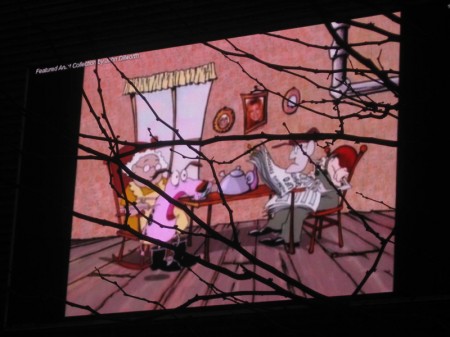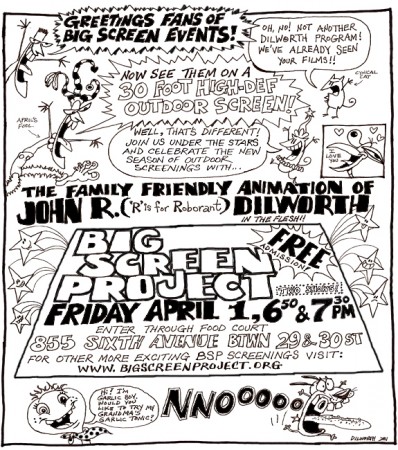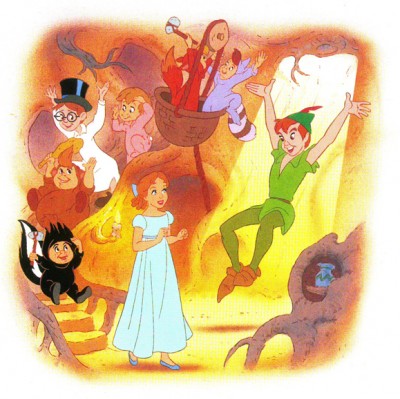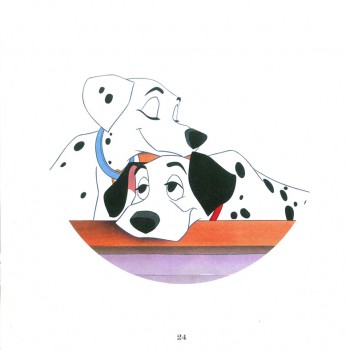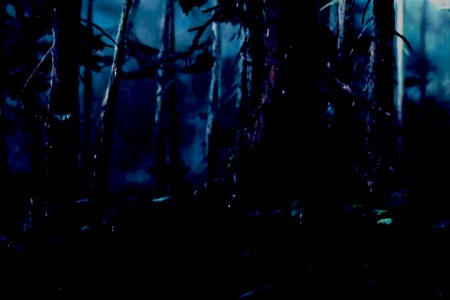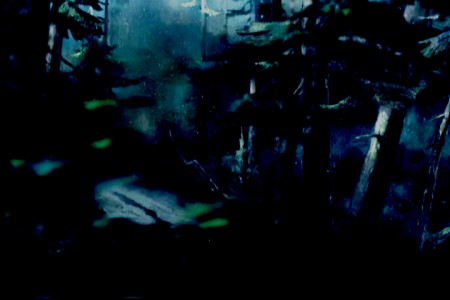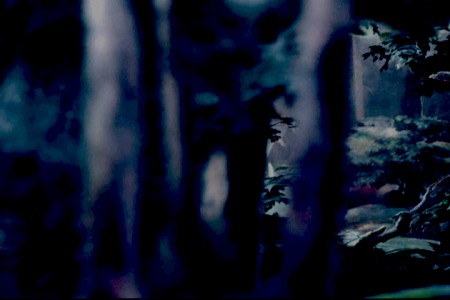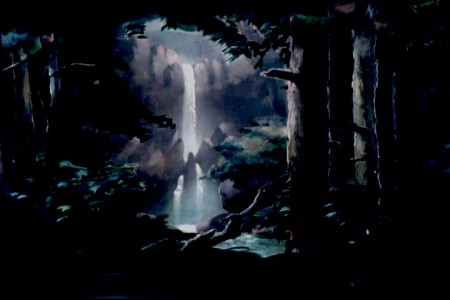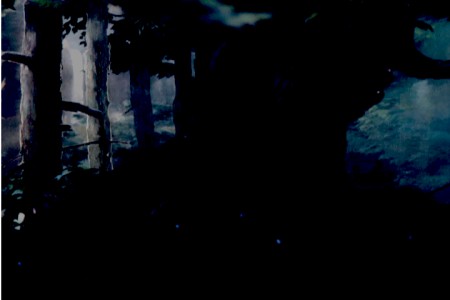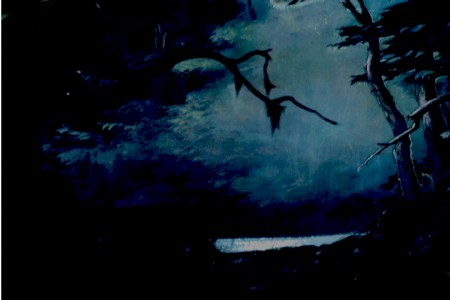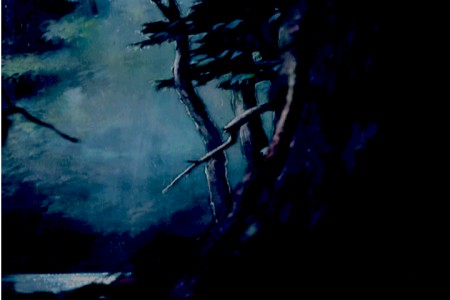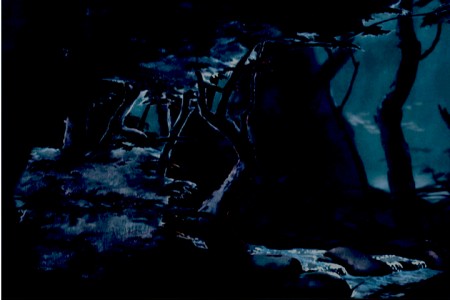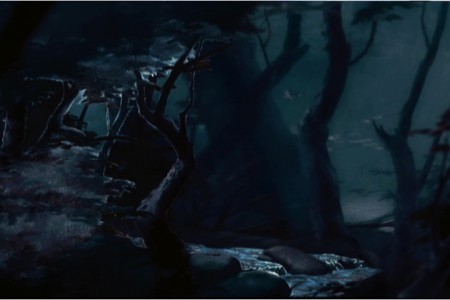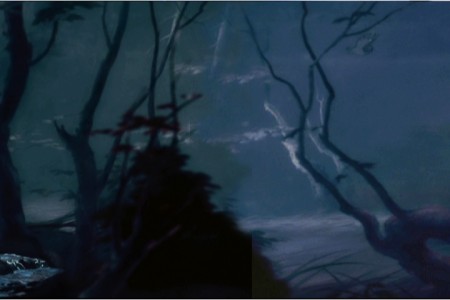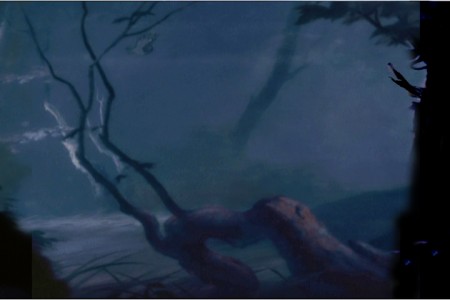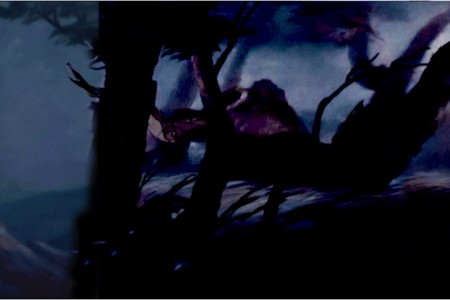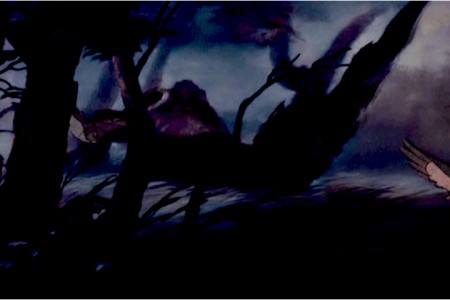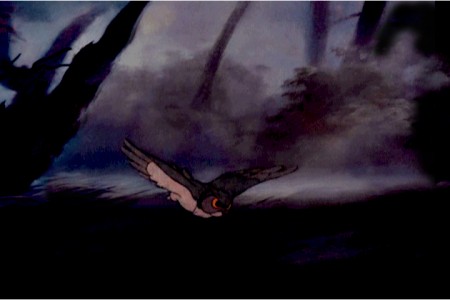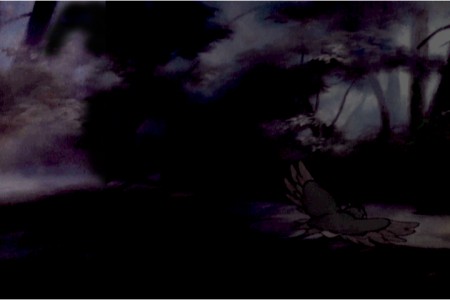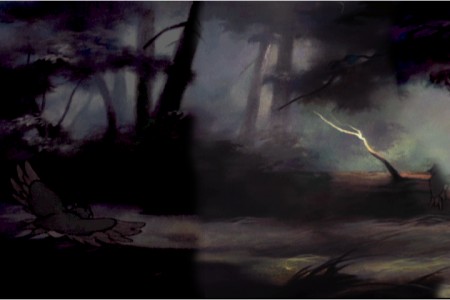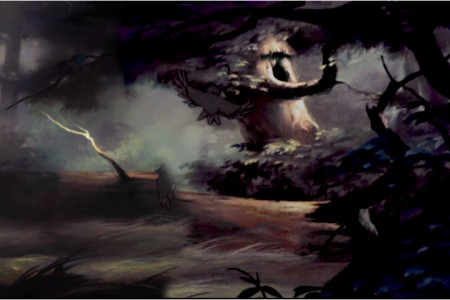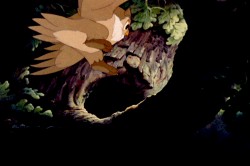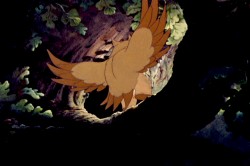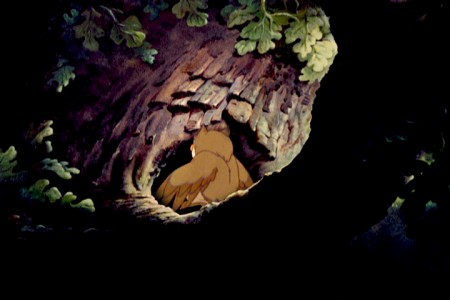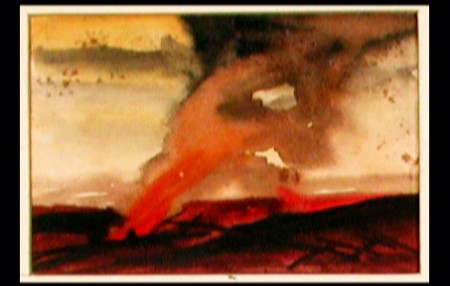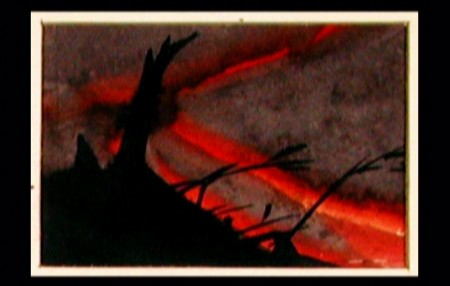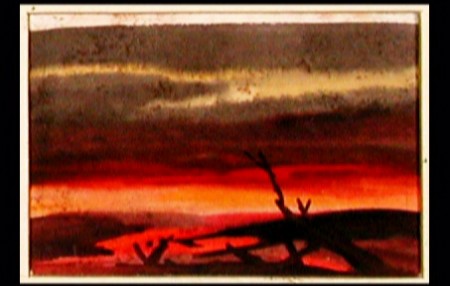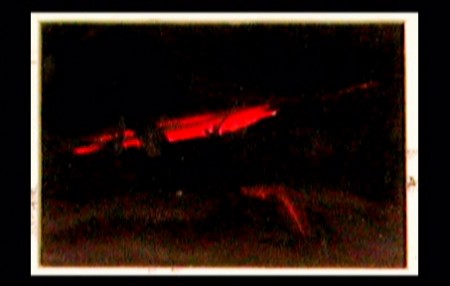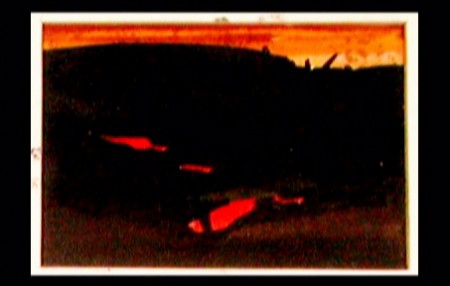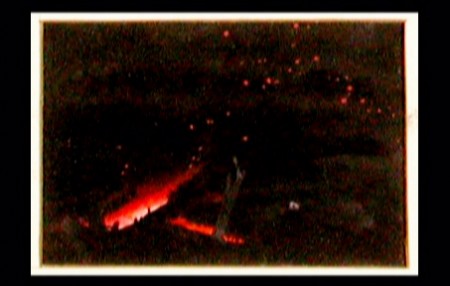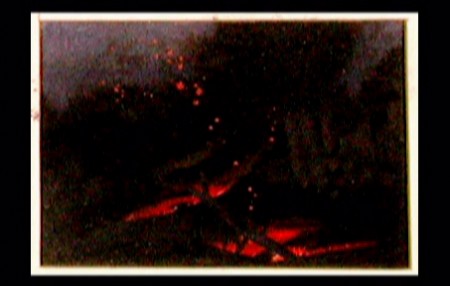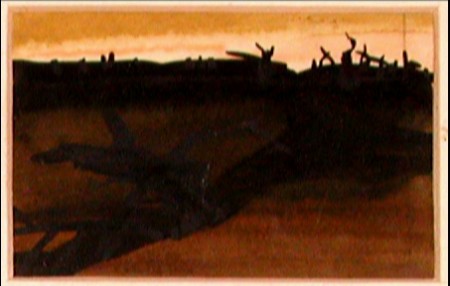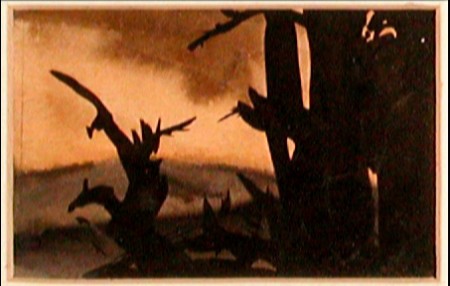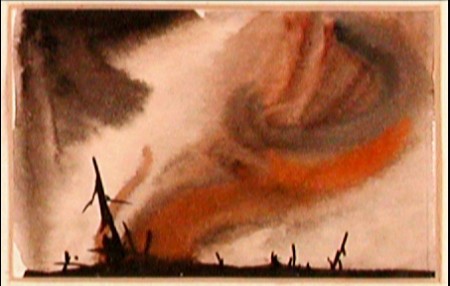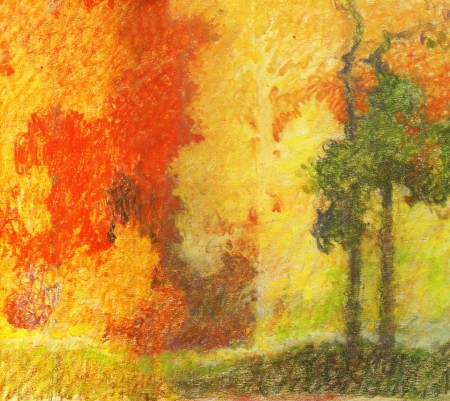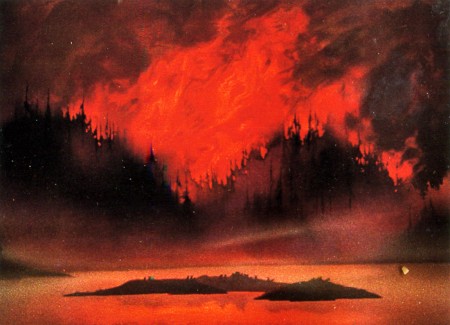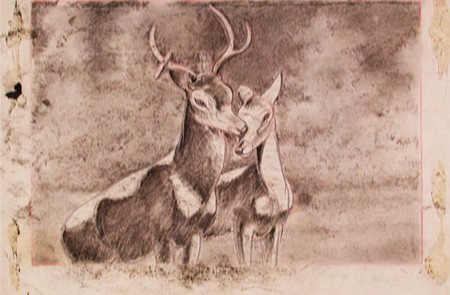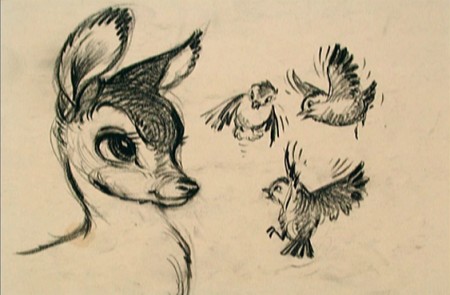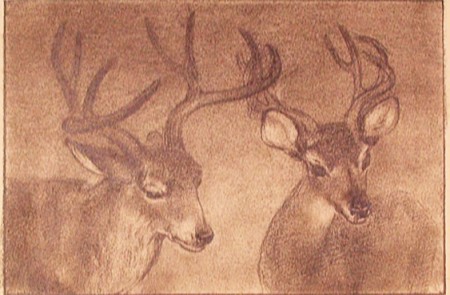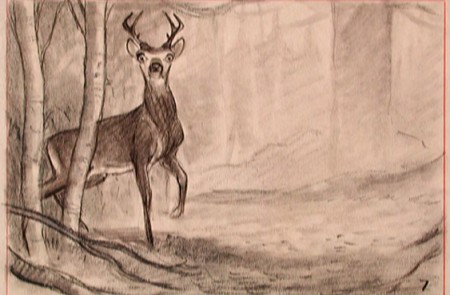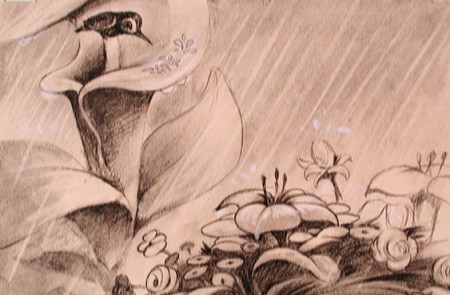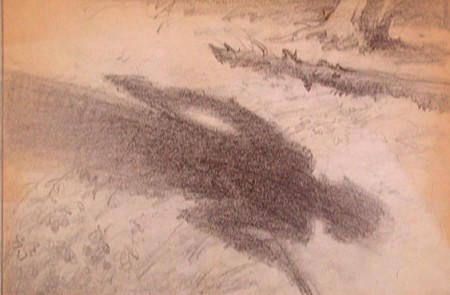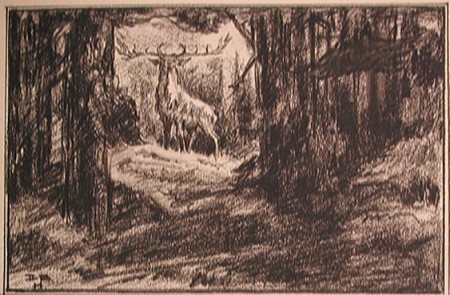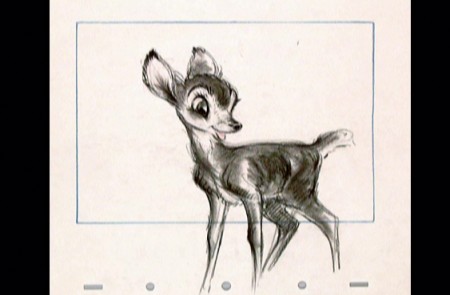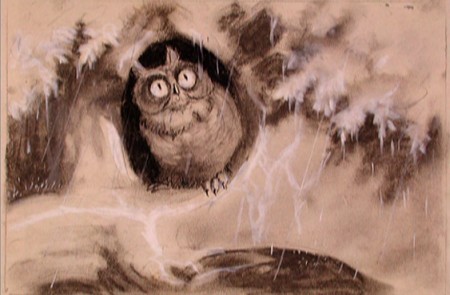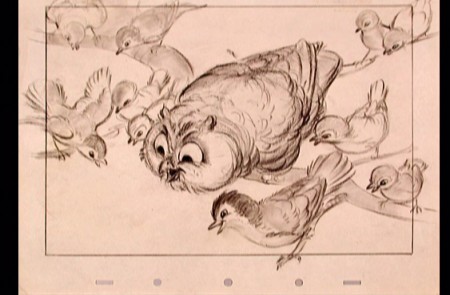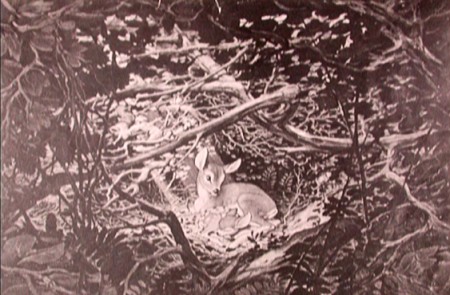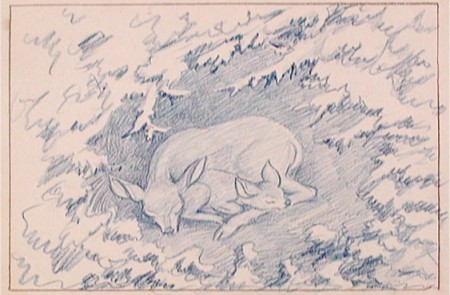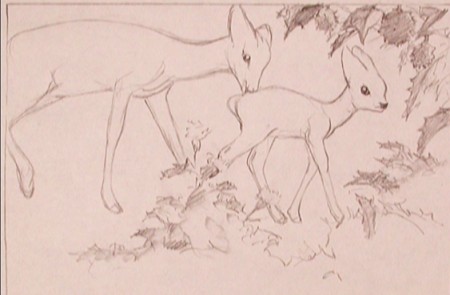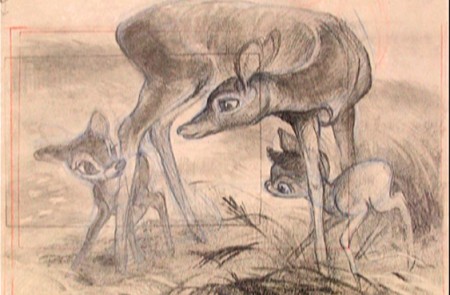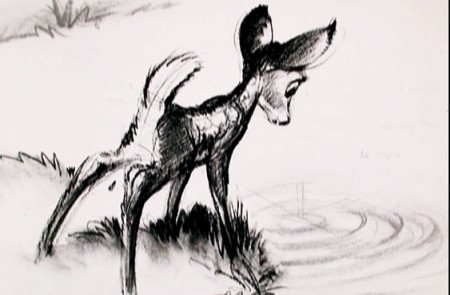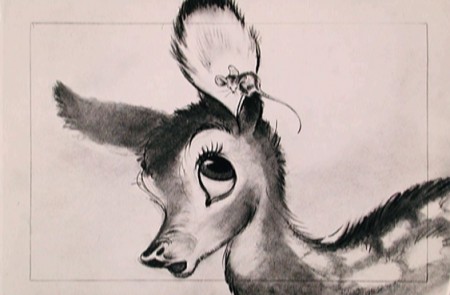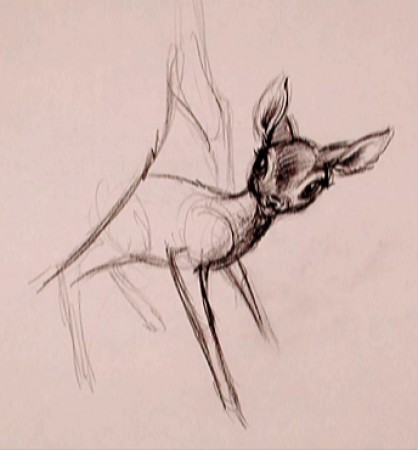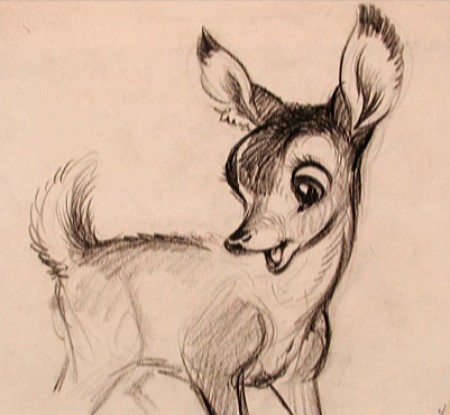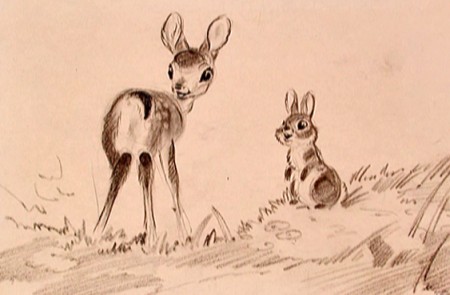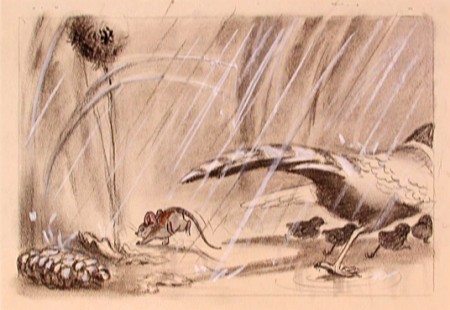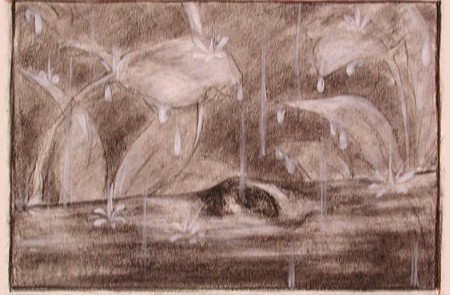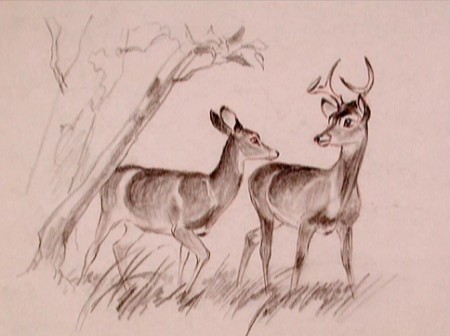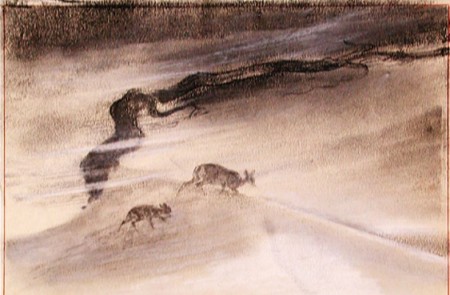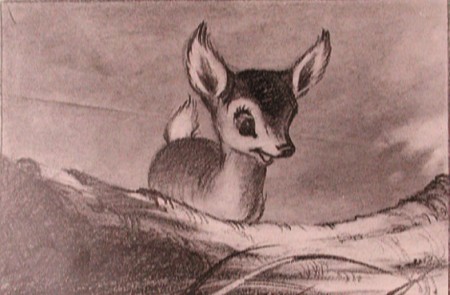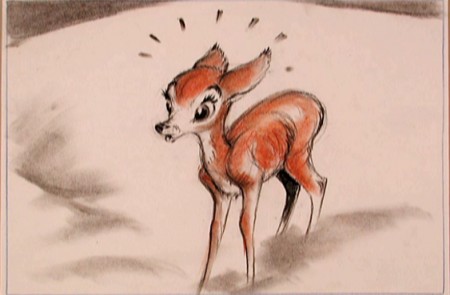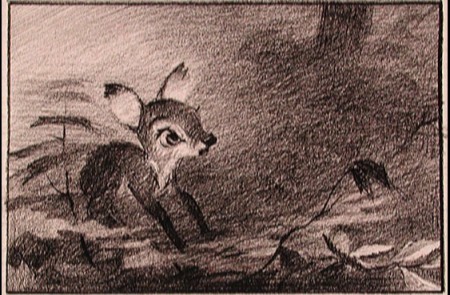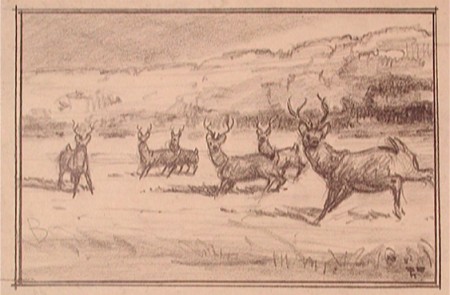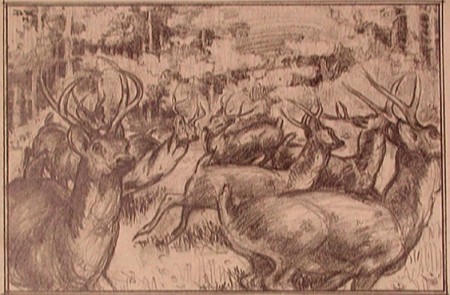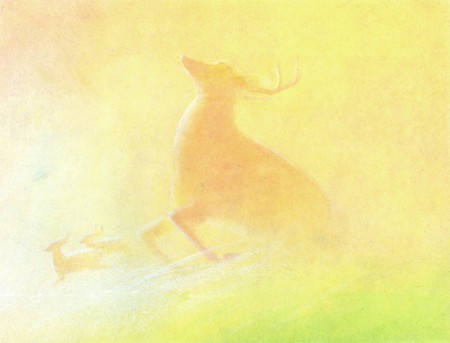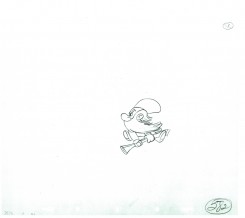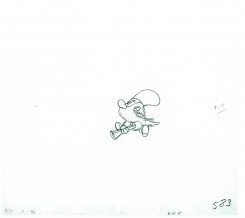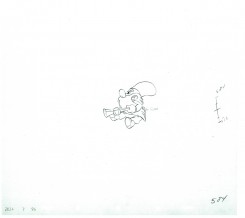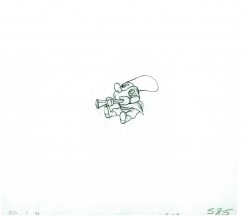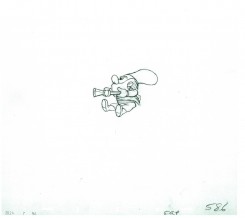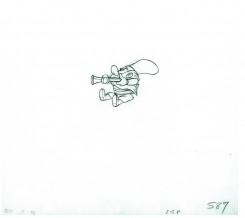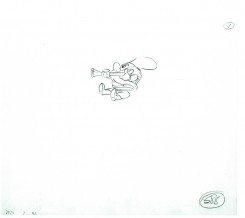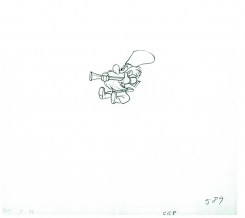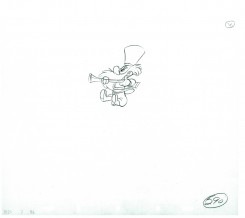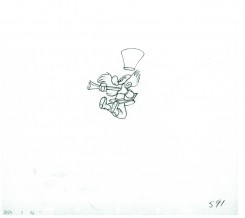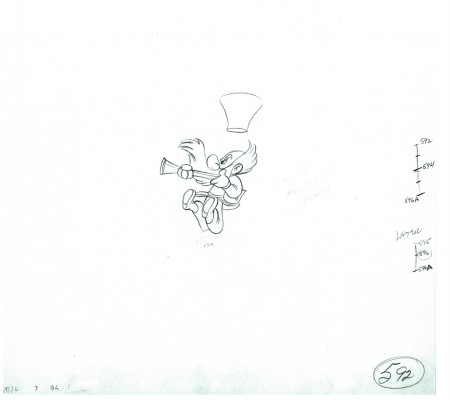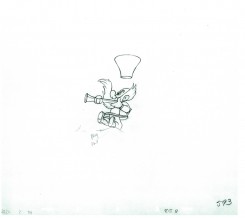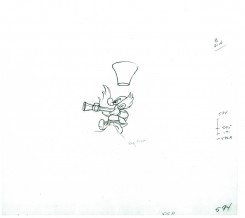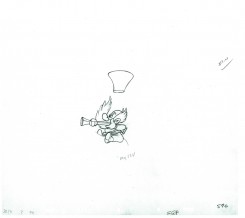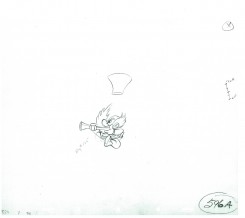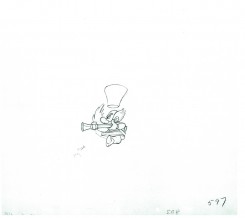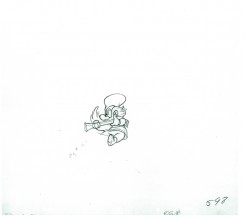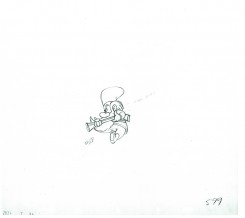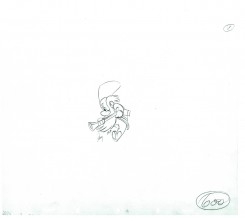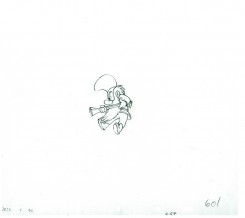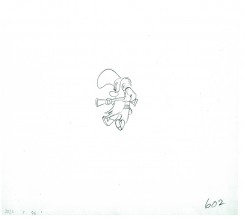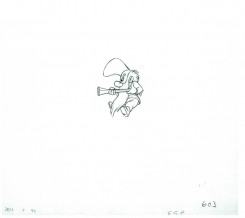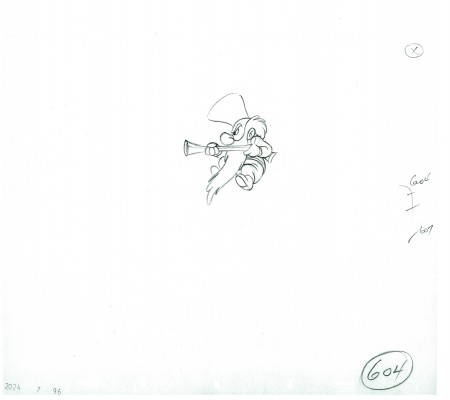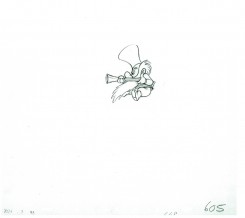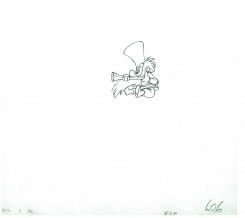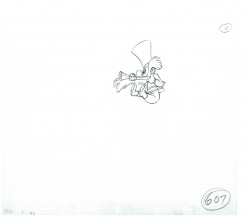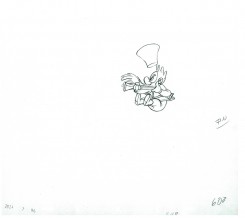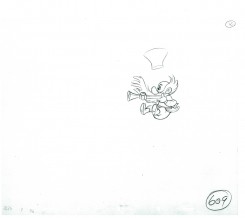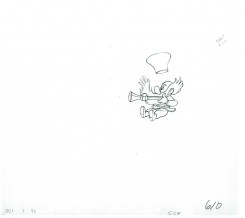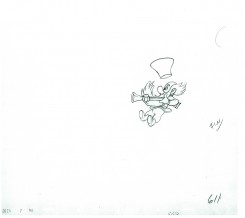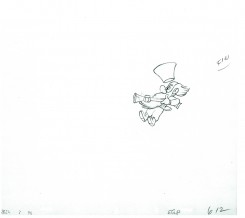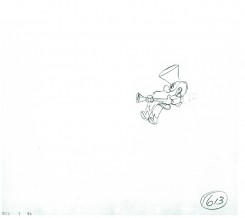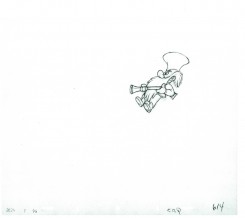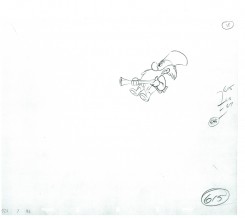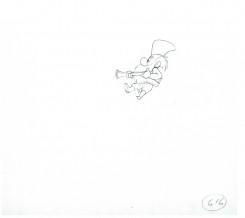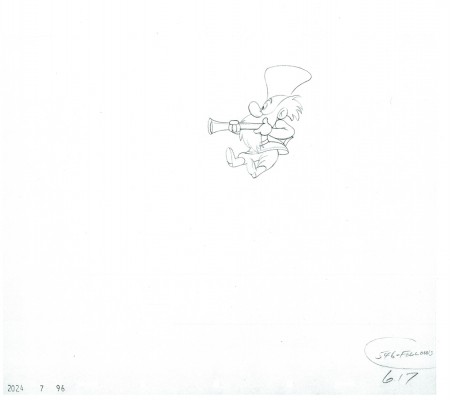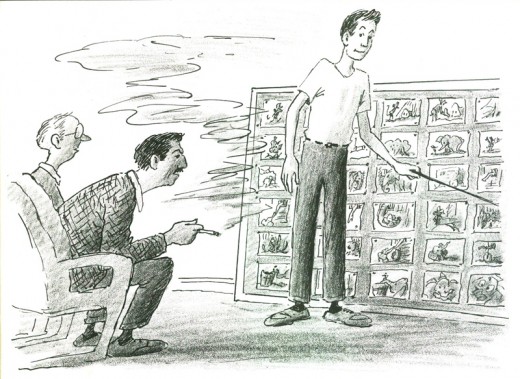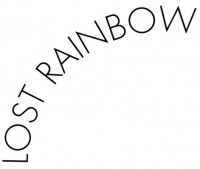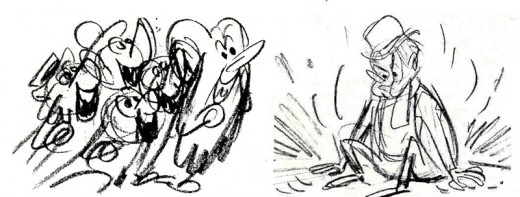Search ResultsFor "bambi"
Commentary 11 Jun 2011 06:49 am
. . . and more
.

- Terrence Malick‘s new film, The Tree of Life, is far and away my favorite of the year, and it’s hard to imagine another besting it. The film starts with a vision of god that moves beyond to a patriarchal dominated family in Waco, Texas. The suggestion of a death leads us back to god and the creation of the earth. From protozoa to dinosaur to the birth of a child, this filmmaker exudes absolute love for every organism he can show us on screen. Yet, right from the dinosaurs onward he creates an ominous tone in this male-dominated power hungry environment. You’re always expecting something terrible to happen in the hands of the children who push the film forward.
This is a film that technically has a new way of presenting itself almost through an impressionistic vision. The whispered narration and dialogue mix and blend into one; the sun streamed backlit late-afternoon interiors create a whispered visual to match. All of it is driven with a new and unusual way of cutting – first seen in Malick’s last film, The New World.
The film only has big thoughts on its mind, and the director’s absolute love of everything pulls us into a world and an environment that is like no other. It’s a great film. Audiences are finding it thrilling and tedious, too long and brilliant. There are many who love it and many who hate it. I loved it and can only question how I can employ some of these new thoughts and devices for my future films. What an inspiration!
I haven’t stopped thinking about it since I saw it on Tuesday.
.
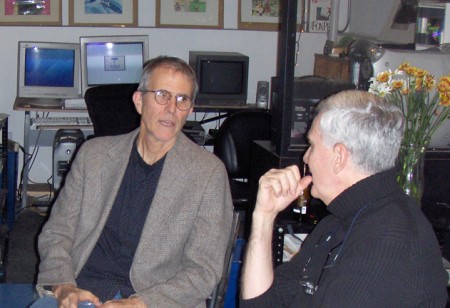
George Griffin & John Canemaker
.
Independent Animators
I’d written last week about regularly featuring articles on this blog about Independent animators. The first one is almost finished and will be run this coming Tuesday. It’s a conversation with George Griffin, an animator whose work has been something of an inspiration to me over the course of my entire career. It was a pleasure putting this piece together for me, and I think it’ll be worth the read.
- John Canemaker has an Appreciation of Tyrus Wong on the blog of the Disney Family Museum. This is an excerpt from John’s book, Before the Animation Begins.
The Disney Family Museum are celebrating Bambi all month with a number of articles, and it might be well worth keeping a watch on what they’ll post for it.
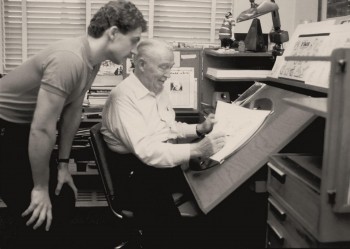 - Surely, by now, most of you know that Andreas Deja has a new blog called, punnily, Deja View.
- Surely, by now, most of you know that Andreas Deja has a new blog called, punnily, Deja View.
If you haven’t visited and are a fan of Disney art, I suggest you check it out. It’s less than a week old, and we’ve already visited Eric Larsen (pictured to the left with Deja), Frank Thomas and Ollie Johnston, Milt Kahl and Marc Davis. The artwork on display ranges from multiple poses of Maleficent to Cinderella and prince dancing, to Pinocchio skipping. We can only assume this material will continue at the same high calibre for a while.
I hope we get some stories and artwork by Andreas Deja, himself, since I have to say his was my favorite animation coming out of the Disney studio in the time he had worked there. It shows how little the studio truly respects animation that they don’t have proper work for a man of his talent. How little respect animation really gets in these days of computerized puppetry.
 - Jeff Katzenberg was interviewed by The Hollywood Reporter about the decline of 3D in movies. In the interview, Mr. Katzenberg had this to say.
- Jeff Katzenberg was interviewed by The Hollywood Reporter about the decline of 3D in movies. In the interview, Mr. Katzenberg had this to say.
THR: Do you have any plans to change your 3D strategy at DreamWorks Animation?
Katzenberg: We’re not the problem. We have made five films now in 3D and have built this amazing reservoir of knowledge and tools. Nobody else has made five 3D movies back to back. You can see the quality of the experience increasing with every film. The cost has gone down significantly for us the last three years, and there is still meaningful, incremental profit to us, even though the size of our audience has narrowed. On every account for us, 3D is a win. It’s not nearly as big a win as it should be, and it’s certainly not the win it was headed toward being, and that’s really heartbreaking to me because we have managed to snatch defeat out of the jaws of victory as only Hollywood can do.
Commentary 02 Apr 2011 08:23 am
Dilworth and 100 Features and Thursday
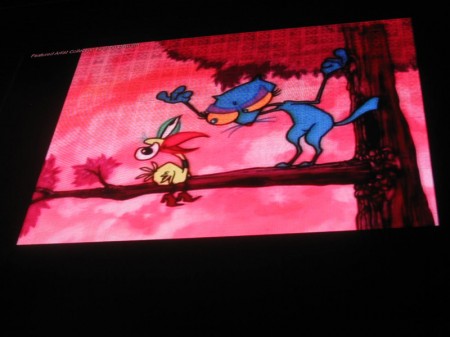
The Dirty Birdy
- Last night was John Dilworth night at the Big Screen Project. As you can see from the above photo, this is a 30 foot video screen plunked mid block off Sixth Avenue between 29th & 30th Streets. John invited lots of friends for the two screenings. Unfortunately, the weather didn’t cooperate, and we had a cool, windy, rainy night.
The event, however, wasn’t spoiled because there was an enclosure into the building, and we were able to look out at the monitor. They hand out closed circuit radios (with earplugs – you take home with you) to hear the sound track (in stereo) while watching from the warm comfort of the building. It’s a food court so there’s plenty of food to purchase or you can have a drink, since the area we watched from was a pub. It made for a fun and interesting experience.
The program was well organized and coordinated by Jaime Ekkens for Big Screen Project.

Looking out to the screen from the bar.

The films absolutely seemed to glow on the crystal clear monitor.
There are plenty of other animators up this April to showcase their films. Go here to see the April schedule. Emily Hubley‘s films are up next on April 11th.
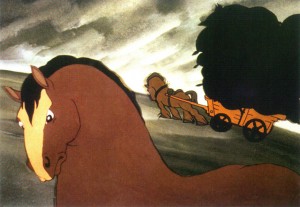 - This past week I received a book in the mail, 100 Animated Feature Films. When the book arrived, I was so taken by the cover design (an image from Lotte Reiniger‘s Prince Achmed, the first full length animated feature) that I immediately opened and started into the book.
- This past week I received a book in the mail, 100 Animated Feature Films. When the book arrived, I was so taken by the cover design (an image from Lotte Reiniger‘s Prince Achmed, the first full length animated feature) that I immediately opened and started into the book.
I was curious about the taste of the author, Andrew Osmond. Would it be another list that would be more studio oriented or more, perhaps, something a bit more siding with the Independent studio. Would his taste run more to the current films or the Golden Age? He’s written a number of articles about Satoshi Kon and Miyazaki for Britain’s The Guardian, so one has a good idea of his preferences.
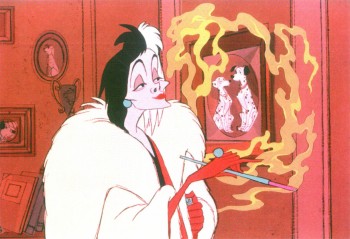 In fact, I found myself pretty well pleased with a lot of the listings. It’s a bit more Anime than I would have gone toward, but I can easily understand the choice. However, there are many expected and deserved choices within the book. I’m glad to see Reininger’s Prince Achmed listed, as, of course, is Snow White. Other Disney titles include: Pinocchio, Bambi, Fantasia, Dumbo, Beauty and the Beast. There are also a bunch of Pixar films, some of which are: only one Toy Story (the original), The Incredibles, Monsters Inc., Finding Nemo and Up.
In fact, I found myself pretty well pleased with a lot of the listings. It’s a bit more Anime than I would have gone toward, but I can easily understand the choice. However, there are many expected and deserved choices within the book. I’m glad to see Reininger’s Prince Achmed listed, as, of course, is Snow White. Other Disney titles include: Pinocchio, Bambi, Fantasia, Dumbo, Beauty and the Beast. There are also a bunch of Pixar films, some of which are: only one Toy Story (the original), The Incredibles, Monsters Inc., Finding Nemo and Up.
Surprises were finding some titles such as:
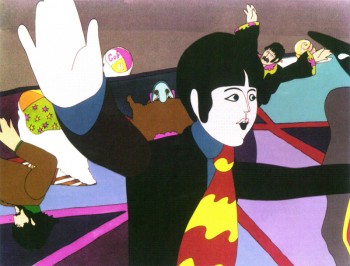 The Thief and the Cobbler. The final film version of Richard Williams’ feature, on the market, is horrible. The one in the works for 30 years was visually stunning. This is listed here for what it might have been.
The Thief and the Cobbler. The final film version of Richard Williams’ feature, on the market, is horrible. The one in the works for 30 years was visually stunning. This is listed here for what it might have been.Sita Sings the Blues. This is the only Flash animated feature included. A truly solo work, Nina Paley, created a thinking film with a lot of glorious sections.
Batman Beyond: Return of the Joker. This is a spin-off the television series, and doesn’t have the weight that any title in such a book deserves.
A Scanner Darkly. I might have chosen Waking Life over this title, but I suppose this has a more coherent story. Regardless, I’m glad to see one of Richard Linklater’s films included.
Avatar. Jim Cameron fought to make sure people didn’t consider this animation. I guess, he’s lost. Animation or Live Action, it’s not a very good film.
Both of Sylvain Chomet‘s films: The Illusionist and The Triplettes of Belleville. They both belong here.
Surprises not found in the book:
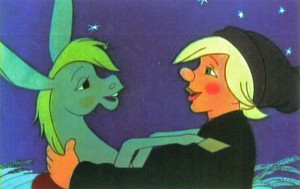 Gulliver’s Travels. Osmond includes Hoppity Goes to Town, but leaves Gulliver out. Excuse me, but Batman Beyond OVER the beautiful Fleischer gem? Something doesn’t smell so good.
Gulliver’s Travels. Osmond includes Hoppity Goes to Town, but leaves Gulliver out. Excuse me, but Batman Beyond OVER the beautiful Fleischer gem? Something doesn’t smell so good.Ratatouille. This is certainly one of the best of Pixar’s films. To include Finding Nemo and not this excellent feature by Brad Bird is just crazy. I suppose he had Bird’s The Incredibles and he wanted to write about Andrew Stanton.
And if you’re going to include films for the sake of the director, wouldn’t Chuck Jones‘ only feature, The Phantom Tollbooth, be included?
Neither UPA feature: Magoo’s 1001 Arabian Nights and Gay Purr-ee were both left out of the book. Given the heavy number of Japanese features, I would have found one to keep out to include a UPA example.
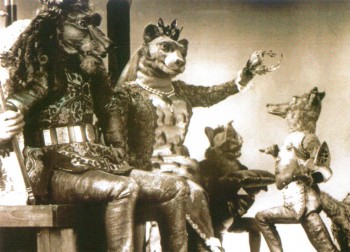 However despite any gripes, I have to say the book is solidly written and intelligently put together with a lot of thought going into the choices. It’s expected I’d have opposing thoughts on the titles included, but I admit to being intelligently challenged by the author. Andrew Osmond did a fine job, and the book is graphically attractive. I do wish, though, that the type were a bit larger. It looks like it’s about 8pt. and it’s too small for my aging eyes. The book was published by BFI Screen Guides.
However despite any gripes, I have to say the book is solidly written and intelligently put together with a lot of thought going into the choices. It’s expected I’d have opposing thoughts on the titles included, but I admit to being intelligently challenged by the author. Andrew Osmond did a fine job, and the book is graphically attractive. I do wish, though, that the type were a bit larger. It looks like it’s about 8pt. and it’s too small for my aging eyes. The book was published by BFI Screen Guides.
The images above can be found in the book.
1) Animal Farm
2) 101 Dalmatians
3) The Yellow Submarine
4) Ivan and His Magic Pony
5) The Tale of the Fox
I saw this film on line last Tuesday. Cartoon Brew posted it on Wedneday. If you saw it there, I’m pleased; if not this is for you. Matthias Hoegg‘s BAFTA nominated short, Thursday, can be seen online here. It’s an excellent film with a lot of the character necessarily developed through the animation. At the same website, there’s also an interview with Matthias about the making of the short. Take the 7 minutes to watch the film. A good use of cgi and 2D.
He’s represented by Beakus. Their site also showcases a number of his films.
Commentary 26 Mar 2011 07:57 am
bits and pieces and screenings
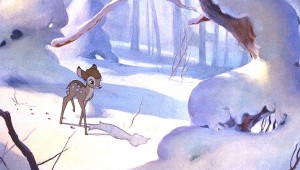 - Before getting into the info section of this post, let me talk about something that’s been bothering me from Disney on TV. Because Disney owns ABC, all their VOD shows have commercials for upcoming DVDs and movies in theaters.
- Before getting into the info section of this post, let me talk about something that’s been bothering me from Disney on TV. Because Disney owns ABC, all their VOD shows have commercials for upcoming DVDs and movies in theaters.
Currently, an ad for Bambi runs at every commercial break, as does one for Mars Needs Moms (or whatever that film is called). The Bambi ads make me feel good watching some of the iconic scenes over and over again: autumn leaves blowing, Bambi’s first steps, Bambi on ice . . . a bunch of them. However, the music is downright annoying. Instead of using music from the film, they’ve hired someone to write a bed of Musak in the usual pop style to cover anything that’s happening on sreen.
Here’s a film that has brilliant music, and it’s all out the door, replaced by audible nothing, the musical equivalent of watered-down milk. It’s just another fine example of the little respect the Disney people really have for their merchandise. It’s like playing an ad for The Wizard of Oz and not using any of the songs. I don’t know; I throw my hands in the air in frustration. At least they’re running ads, I suppose. But they treat Mars Needs Moms with more respect and play the hyper music from that film during its ad. No synth-pop composer has been called in to write a bed of nothing.
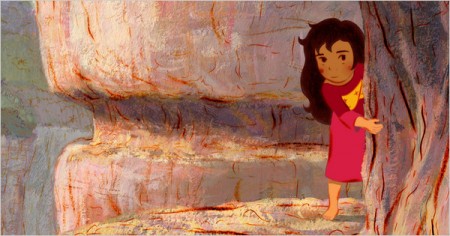
Mia and the Migoo
- The French animated feature. Mia and the Migoo, officially opened in New York, yesterday at the IFC Center, downtown. The film won as best animated feature at the 2009 European Film Awards.
The film has recieved mixed reviews from New York’s critics.
NYTimes said: “… trying to parse meaning in “Mia†is secondary to its main point, which is its look, created with 500,000 hand-drawn frames. That’s impressive in an age in which most mainstream animation is done with computers …”
The NY Daily News said: ” … though the animation can be transporting, its lack of lyricism is disappointing.”
The NY Post said: “France’s animated feature “Mia and the Migoo” is far too childish to intrigue adults yet too slow and dull for kids.”
You’ll find film times and schedule here.
- As it happens, the South Park guys, Trey Parker and Matt Stone, also opened their first Broadway musical yesterday. The reviews for The Book of Mormon were “Golden” as they might say. All four stars, all praise, all the time. This is obviously going to be the big hit of the year. Forget about it; it’ll be imposssible to buy a ticket.
NY Times, NY Post. NY Daily News, Wall St. Journal
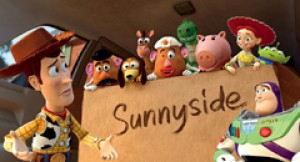 Ken Priebe sent the following notice:
Ken Priebe sent the following notice:
VanArts is hosting our Pixar Artists’ Masterclass with Andrew Gordon and Mike Venturini in New York City this summer, and also in Montreal (and Austin TX).
Registrations are now open for NYC, happening June 24th-25th, so we hope to have your friends, students and colleagues join us.
All information is available here.
- It’s become news when Maurice Sendak announces a new children’s book. According to the Wall Street Journal article, his latest book will be published in the Fall. It’s built from a character he developed for Sesame Street with Jim Henson. Apparently, the character, “Bumble Ardy” stuck in the author/illustrator’s mind, and now, at the age of 82, he’s developed it into a book. Unfortunately, no pictures of the character came with the article. However, here’s the original Sesame Street spot. Sendak has changed the boy into a pig.
______________________________
John Dillworth is having a BIG showing of his films at the new venue the Big Screen Project. All the information you need is posted above.
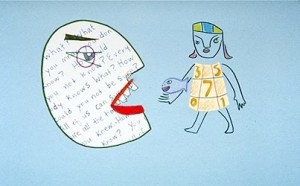 Additionally, Emily Hubley will be having a screening of her films at this site on April 11th. All the information for that screening can be found here.
Additionally, Emily Hubley will be having a screening of her films at this site on April 11th. All the information for that screening can be found here.
The films she’ll screen will include:
One Self: Fish/Girl
Enough
The Tower (made w Georgia Hubley)
Set Set Spike
Delivery Man
Octave
Blake Ball
Likewise there will be other screenings during the month of April. Go here to find out about Elliot Cowan, Nina Paley, Bill Plympton and Deborah Solomon‘s screenings.
Books &Commentary 24 Mar 2011 07:15 am
Disney books
- Lately, Disney’s book divisions have done some wonderful work. The Archive series: Animation, Story, Design and soon to come Layout & Bg are all stunningly attractive books. These are top of the line items from Disney Editions. John Canemaker‘s Two Guys Named Joe also comes from the same division, and it’s a beautifully designed and attractively produced book.
But what about the lower end of the Disney Publishing empire? In the bygone days the animated features would be made into Little Golden Books utilizing artists from the studio. Mary Blair, Al Dempster, Bill Peet, and Eyvind Earle all contributed to books for the Western Publishing offshoot. Today there are still some Little Golden Books being made from Disney material. The Pixar product, such as Toy Story and Wall-E, as well the Disney Princesses and The Princess and the Frog all have editions.
However, I came upon something even lower down the pipeline. Here are three books that were produced for Walgreen’s pharmacy megastores. Heidi bought them 3 for $3.98. None of the books gives a hint of illustrator or writer. The illustrations, on a very cursory glance, look as though they might have been frame grabs pulled from the movies.
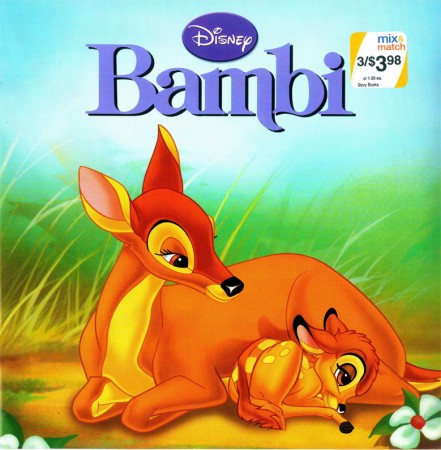
Bambi’s cover. It’s a nice watercolor evocative of the film. Though one
wonders why they played with the logo’s type. The “m” now has a
little swoosh on its lower right. Not part of any other version of this title.
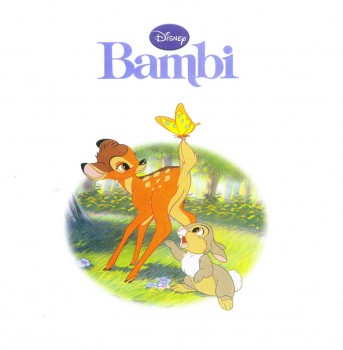
Our first interior illustration looks like it might
have been a frame grab from the film, itself.
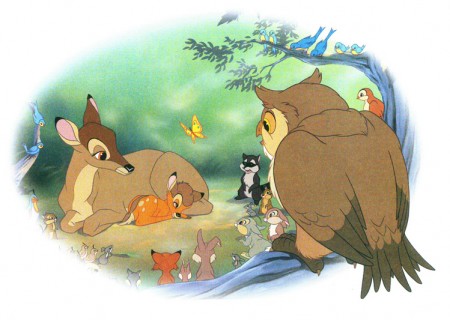
This tries hard to look like it might have come from the film.
But all the characters are moved around differently.
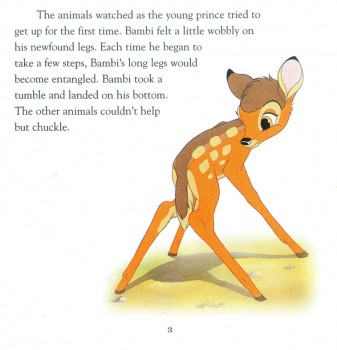
They do a nice job of layout using this iconic image against the type.
Looking at this book, I’m amazed how many well-know still images there
are in the original feature. Those old guys knew what they were doing.
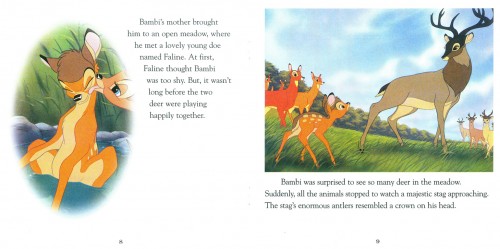
Here are a couple of double page spreads. I like the way they
handle them in these books. You can see that there is a plan.
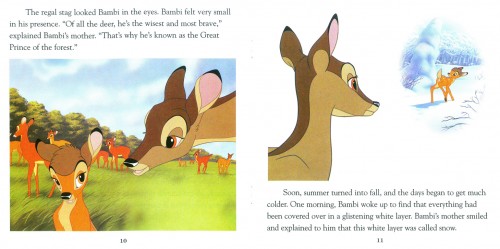
By now, the illustrations look more like Bambi 2 than the original.
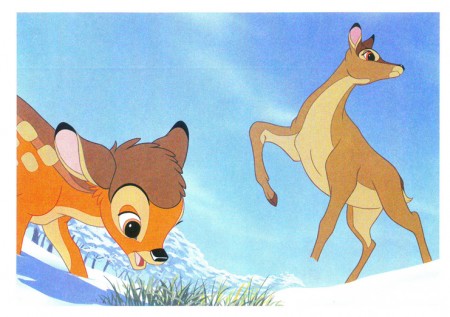
The characters were obviously done on separate levels. Notice the
mother’s leg doesn’t match the background. She’s out of place.
Something you might have seen back in the days with the use of cels.
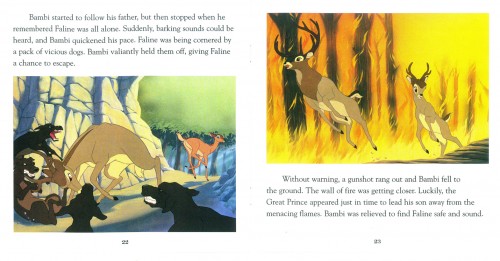
Two pages covers the climax of the film, Faline’s encounter
with the dogs and the fire rates one illustration.
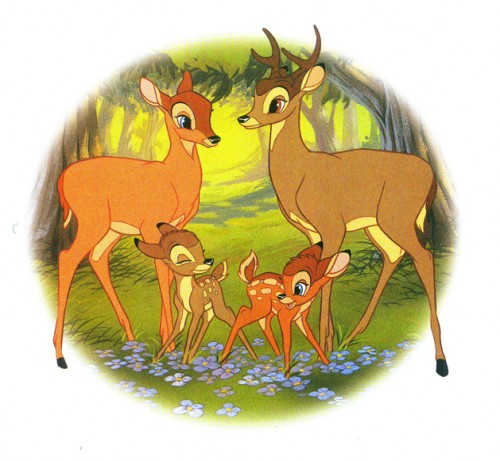
The final illustration takes us into “Bambi’s Children” and
has nothing to do with the original film, anymore.
Peter Pan
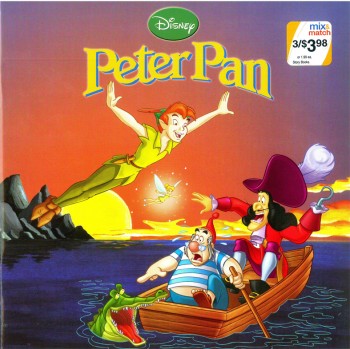
Peter Pan gets off to a bad start with a RED cover
and an action illustration. Not quite the film.
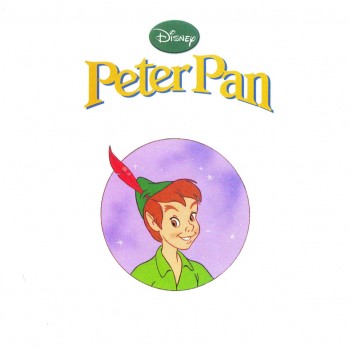
Get to the title page, and Peter is WAY off model.
Oh well.
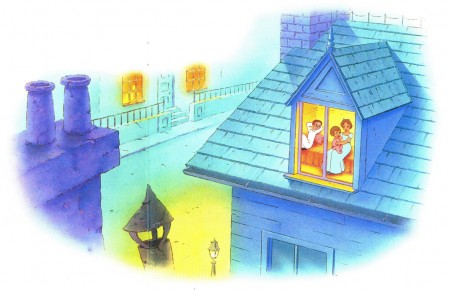
When I think of that beautiful opening shot in the film, it isn’t
quite this. I’m afraid, the Bambi book will be the best of the lot.
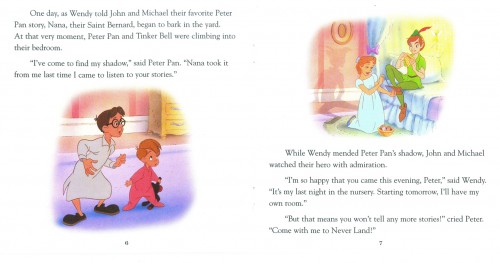
The double-page spreads do still play a bit with the form.
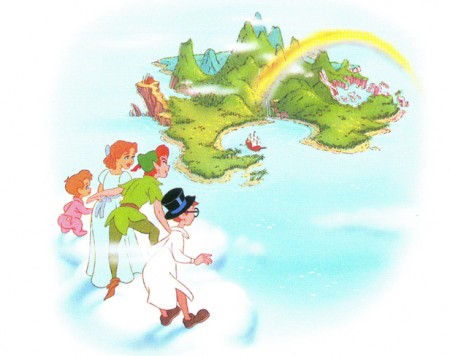
Not much magic left in this Neverland.
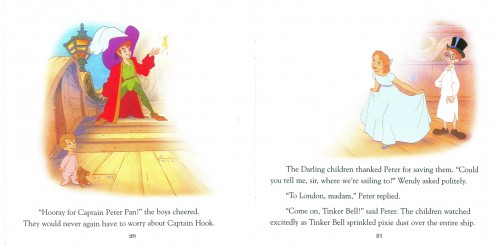
Most of the book is done in Long Shots. I’d say that’s
not the best choice for smallish illustrations. And the
airbrushed white is too opaque to work as a border; it
gets to look like a virus in the air.
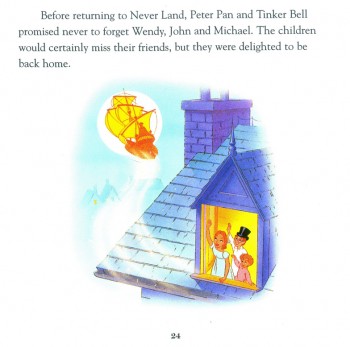
The book is too much on the red side. Everything here is
violet and yellow. Not quite the colors invoked by the
orinal designers.
101 Dalmatians
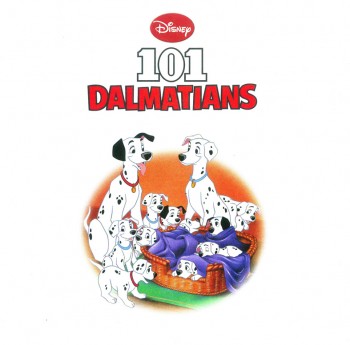
The title page makes for a good composition with bad colors.
The technique, using gouache starts to peek through.
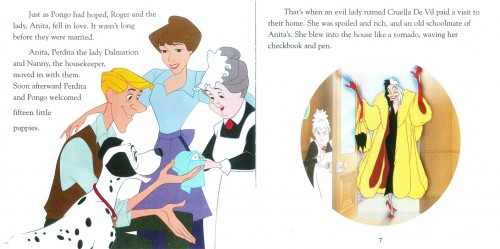
They’ve captured the pose and lost the film.
Where’s that beautiful cut-glass rose in the door?
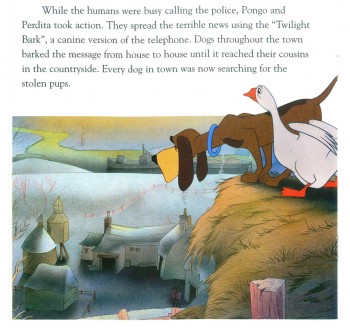
Too bad they’ve ignored the wonderful background styling
of Ken Anderson and the painting of Walt Peregoy.
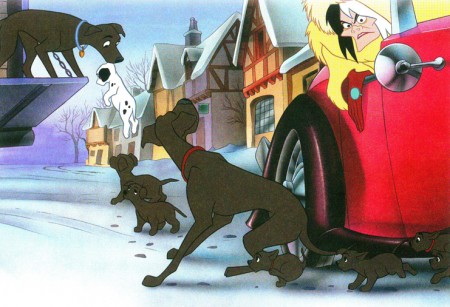
A lot of action. Not a bad image though Cruella’s been simplified.
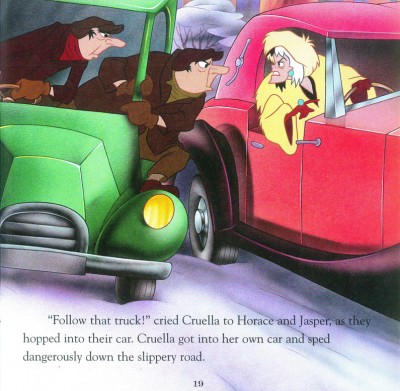
We’ve ignored the great design of the film and have gone to “storybook 2009″.
(The books were done in 2009.)
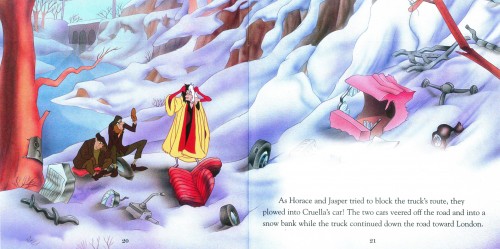
The two page spread makes use of its format, I have to say that.
All in all, I’d have to say it’s probably not a bad deal for parents looking for cheap books to entertain their children. The Bambi book holds up nicely. Peter Pan wastes a great story and 101 Dalmatians works hard to reduce their story into a small book you’d buy in a drug store.
The art and delicacy of the Little Golden Books is gone. Take a look at this, or this, or this. They all varied wildly from the film, but with a sense of originality and design. These three Walgreen books all try doggedly to resemble the film while losing the artistry in the book.
Disney &Frame Grabs 07 Mar 2011 08:13 am
Bambi – Into the Woods
- The new Blue-Ray/DVD has just been released for Bambi. It was less than a year ago that I bought the “Platinum Edition” of this DVD, so, not owning a Hi Def TV, I’ll hold onto what I’ve got, for now.
However, it did make me look at the film again. First off, let me say this is one of my favorite films. I don’t like the cartoony “Twitterpated” sequence, but I do like everything else. Secondly, let me say that they’ve done all they could to destroy the film in cleaning it up with their digital mastering. All the film grain seems to have disappeared and the images feel flattened out. They often come off as garishly colored rather than the sensitive painting that was done.
Thirdly, let me say that, regardless, this is a great movie.
I’ve decided to make some frame-grab sequences to display. How can you not start with the very beginning of the film. That endlessly long pan with the many-levelled multiplane camera hard at work. There are also rear-screen projections (such as the waterfall) that have been built into the pan.
I’ve done my best to connect the frame grabs to simulate the length of the pan. Then I had to break it into four parts from start to stop so as to post it. Each one of these four read well when enlarged. For the thumbnails, I broke each of the four into parts (with a slight overlap) so you could look a little closer.
I hope to pull a couple of other sequences at a later time. This film deserves all the honor it can get. It can’t be beat.
 1
1The pan opening to the waterfall.
Animation Artifacts &Disney &Illustration &Layout & Design 01 Mar 2011 08:37 am
Thumbnails from Bambi
- A lot of pre-production artwork from Bambi has been released in numerous forms. One of the groups of images I find particularly interesting is a host of thumbnail paintings that an art director had done trying to get quick sketches of the backgrounds for a sequence. These seem to all come from the forest fire sequence. They could be Maurice Noble or John Hubley or Tom Codrick or Al Zinnen. Or others. There were great artists backing up this film.
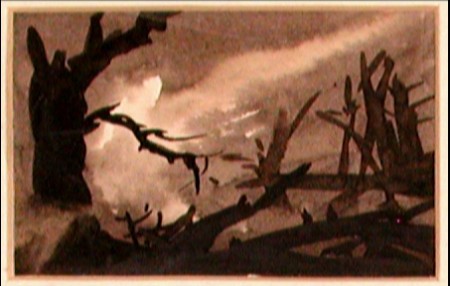 1
1
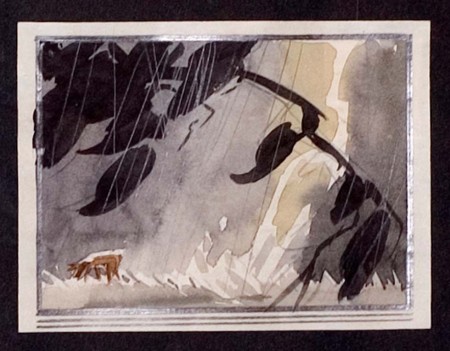 15
15
Tyrus Wong
Loaned from the Cowan collection.
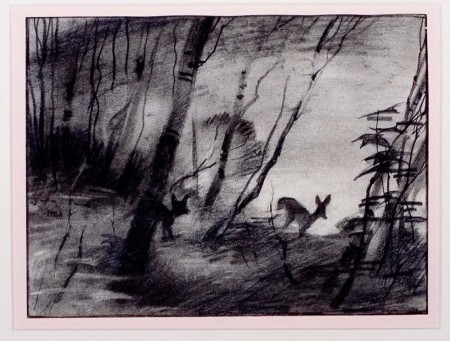 16
16
Loaned from the Cowan collection.
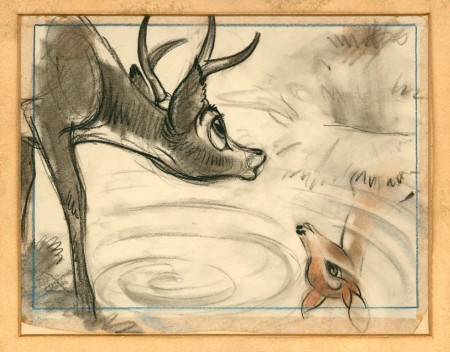 17
17
Marc Davis
Loaned from the Cowan collection.
Animation Artifacts &Disney &Layout & Design &Models 28 Feb 2011 06:50 am
Bambi – drawings
- It all starts with a drawing. Bambi is, to me, one of the most beautiful of animated features. Collectively, the artists at the Disney studio pulled together to create some wonderful artwork which produced a wonderful film.
The initial work went through many phases, as would be a natural state for animation. However, all of the artists seem to be trying for a higher plane, and oftentime they reached it.
To celebrate the latest release of this film, the Blu-Ray/DVD version, I’ve pulled a lot of the drawings from the film and post them here. It’s amazing how much nifluence Marc Davis had early on. I can only ID the artists of some of the sketches. If you know, let me know.
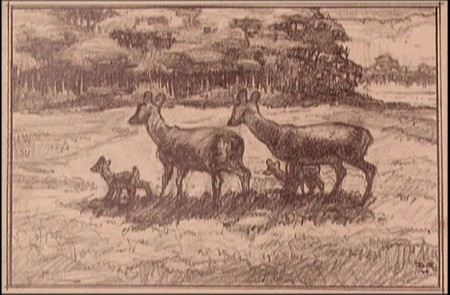 1
1David Hall
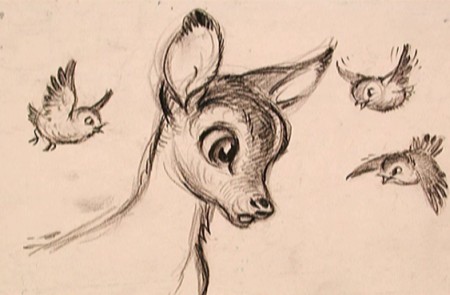 3
3
(above and below) Marc Davis
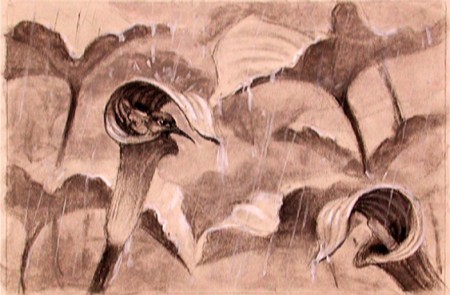 7
7
(above and below) Ken Peterson
Animation &Animation Artifacts &Disney 04 Aug 2010 06:21 am
P&W-Kimball Scene – 8
- Production #2024, MAKE MINE MUSIC, “Peter and the Wolf”. Sequence 7, Scene 96. Animator: Ward Kimball.
Completing the post of the little guy on the separate level, here are the final drawings of the scene. There are other levels of snow animation and footprint animation, but I won’t post those. This scene was large enough.
As usual, we start with the last drawing from last week’s post.
Enjoy.
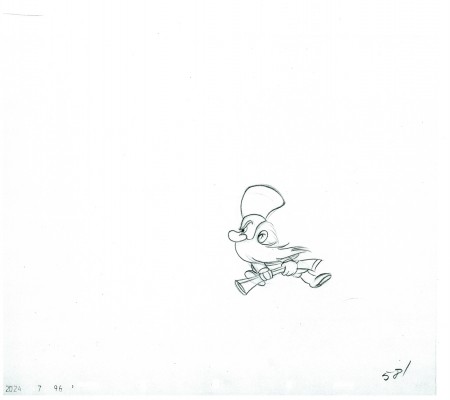 581
581
The following QT movie represents all the drawings of the bottom level
as well as the drawings of the Little Guy, on another level,
who comes in and out where he should.
I exposed all drawings on ones.
Right side to watch single frame.
To see the past five parts of the scene go to:
Part 1, Part 2, Part 3, Part 4, Part 5, Part 6, and Part 7.
My thoughts on this scene – just my opinion
I’m pretty disappointed in what I’ve seen here. The work has the obvious flair and panache of a typical Ward Kimball scene. The movement is funny and creative. Kimball did his work. The assistants were out to lunch.
The drawing in the scene is not the top notch material I’d expect of a Disney team. Seeing it drawing by drawing I get to see what I don’t like from a lot of the work in this period. The drawing just changes and doesn’t live up to the originals. Just looking at the fingers you get to see them turn into, what we in NY call, “Banana fingers” – they flatten out. This is part and parcel of the work at Terrytoons or Paramount, but we’re talking Disney here. You wouldn’t catch that in Sleeping Beauty or Bambi or Dumbo or Snow White or 101 Dalmatians. But it’s there in these compilation features.
Now going through the many drawings I’ve posted by Bill Tytla, I notice a distinct tie to Terrytoons. In the dwarves and especially in Stromboli a soft roundness comes into his drawings (and the assistant keeps it) at times. It’s probably the influence of Connie Rasinski while Tytla was there. It isn’t a bad thing, it’s certainly part of the style Tytla brought to his work. He took something good from Terry (the bottom) and brought it to Disney (the top), and he made it work into something glorious. If anyone was an artist in animation, it was Bill Tytla. But that isn’t what I’m talking about with the work in this Kimball scene.
All right the schedule was probably ridiculously tight – it was – and the budget was probably underbudgeted – it was. But I remember Jack Schnerk (who assisted at Disney) telling me about the last six months of work on Bambi when work went into overdrive. Everyone was forced to work seven days a week and most slept on their desks to get it done. The work was so heavy he quit after the film was finished. But then that was pre-IATSE and the compilation features were not. That was also when Walt was intimately involved in the films and he was not so involved in the compilation films.
Something different: for some reason WordPress will not let me save the word “‘O’nion” (replace a “U” for the “O” and you’ll have the word I mean.) If I try to save a piece with that word in it, it erases the material. I’ve used IATSE in its place for this piece. This has gone on for the last year. Anyone with a suggestion?
Animation &Disney &Peet 15 Jun 2010 08:10 am
Bill Peet & Dumbo animation
- There’ve been a lot of comments on my blog about how Bill Peet just about re-animated the bathing scene for Bill Tytla. I thought it worth looking into what I could find in print. To start with anything BUT Peet’s autobiography would be foolish, so let’s see what he wrote about his time on Dumbo within that book.
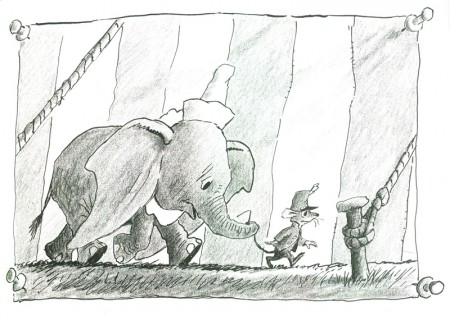
- The intimidating big business atmosphere of the new building became much less difficult for me when I was assigned to work on Dumbo, the story of the little circus elephant with the enormous floppy ears. Otto Englander, the supervisor of Dumbo, was familiar with my work on Pinocchio and gave me a large part of the story to develop on my own.
The year and a half I spent on Dumbo was a happy time especially since our first son, Bill, was born just the year before I went to work on the picture, and my infant son was a definite influence on the way I drew the baby elephant.
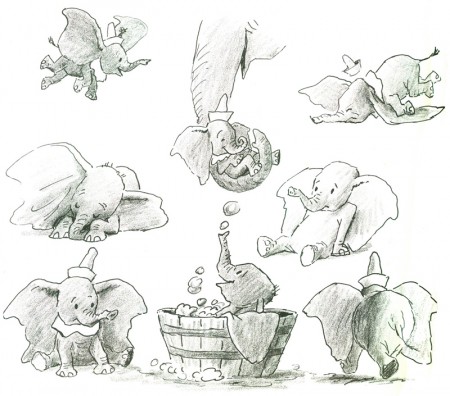
With all my years of sketching and painting the circus I was well prepared for Dumbo, and I contributed so much to the production that Otto allowed me to present my story boards to Walt one day.
In facing Walt for the first time I understood why so many story men became so nervous and shaky they often lost their voices. It was an unnerving experience to concentrate on the boards while Walt leaned forward in his chair as if he were ready to pounce.
Hi fierce scowl was also disconcerting even though it was usually a sign of deep concentration.
I was greatly relieved to make it through the boards without faltering and find Walt relaxed and smiling.
But then Walt was enthusiastic about all my boards on Dumbo, and I thought sure I was established as a full-fledged story man on films to come. No such luck!
Here’s what Peet had to say in an interview done on Hogan’s Alley.
- Bill Peet: Walt got a little stingy with us on Dumbo because they had a showpiece with Bambi. They could play around with little things like the raindrops. Beautiful, but slow and expensive. We weren’t allowed any trimmings. Bambi was a wedding cake. Dumbo was one layer with a little bit of icing. Ours was more successful because it had common appeal, even though the animation was crude in some places. Dumbo didn’t make big money. It had only cost $800,000, so all it had to do to make its cost back was go a little over $1 million. The other features had cost $3 million, plus the cost of the prints, and with no foreign market because of the war.
John Province: Two of the best, Bill Tytla and Fred Moore, worked on Dumbo.
Peet: People were always amazed at Bill Tytla, that he could draw the giant devil for “Night On Bald Mountain,†and the giant in “Brave Little Tailor;†these ponderous, muscled characters, and then do this little elephant. After he got his first scene on Dumbo, he passed me in the hall and said, “Y’know, Bill, I can’t draw these goddamned little elephants. If I send Nick [his assistant] up with the scene, would you see if you could work it out?†Nick brought up this stack of drawings, Bill’s scene where the elephants first appear was just a mess. So I went over every one of them, probably a couple of hundred drawings, every damned frame in the picture, and redrew the whole scene. They shot the pencil test and showed it to Walt. He was ecstatic! Nick came up and told me, “Walt loved that thing, and I want to shake your hand!†Well, Bill never bothered to thank me, Walt either.
Reworking drawings is not animation, and Bill Peet knew that as well. Animation is all in the timing. I also doubt that a sequence that long would have only had “a couple hundred drawings” (even if that isn’t an exaggeration.) I don’t think Peet is giving Tytla his due. Certainly he deserves some attention for pulling the character on model and showing the assistant how to handle it, but there’s a lot more to it.
Mike Barrier, in his inestimably valuable book, Hollywood Cartoons, reports:
- Jackson, who directed all the sequences with significant amounts of animation by Bill Tytla, handed out scenes to Tytla, “but there would be others who would work with him who would do certain scenes…. Quite often Bill would knock out a few poses to get them started and would supervise what they did, very carefully,” to the point that he accompanied those junior animators when Jackson looked at their pencil tests in sweatbox sessions.
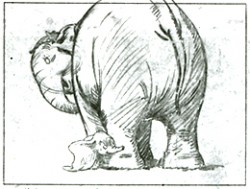 If Tytla had trouble drawing Dumbo, he wouldn’t have had so much authority over the junior animators. I have no doubt Peet got him up and going with the initial scenes, but Tytla is evident in every drawing credited to him in that film. He did that animation.
If Tytla had trouble drawing Dumbo, he wouldn’t have had so much authority over the junior animators. I have no doubt Peet got him up and going with the initial scenes, but Tytla is evident in every drawing credited to him in that film. He did that animation.
Personally, I think this sequence is brilliant enough that both men deserved the credit of genius. It’s one of the high-water marks of animation in its entire history. I also think it’s doubtful that we’ll see its like again.
Articles on Animation &Hubley 25 Feb 2010 06:40 am
Finian’s Rainbow – alt
Yesterday I posted this very same article by giving the PRINT Magazine layout. Today I offer an alternate version, since I think it’s an important piece, wherein the text would be html and the illustrations could be posted larger. Hence, I’ve decided to post it twice, for whatever that’s worth. At least it allows me to keep it running for second day.
.
.
by John Canemaker
Animation innovator, John Hubley was slated to design and direct a film version of the Broadway hit, Finian’s Rainbow. But this was the fearful 50s and the witch-hunting zeal fo the time doomed the project. All that remains are 400 storyboard sketches which recently surfaced and are sampled here.
.
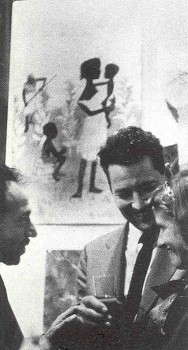 On January 10, 1947, the musical Finian’s Rainbow opened on Broadway to rave reviews, precipitating a successful run of 725 performances. In the fall of that same year, the U.S. Congress-approved House Un-American Activities Committee (HUAC) began a long-running show of its own: the official sanctioning of an “Inquiry into Hollywood Communism.”
On January 10, 1947, the musical Finian’s Rainbow opened on Broadway to rave reviews, precipitating a successful run of 725 performances. In the fall of that same year, the U.S. Congress-approved House Un-American Activities Committee (HUAC) began a long-running show of its own: the official sanctioning of an “Inquiry into Hollywood Communism.”
Amid the wreckage of lives and careers cut short during a decade of insidious HUAC-inspired fear and persecution were numerous film and TV projects fated never to see completion, including a feature-length animated cartoon version of Broadway’s Finian’s Rainbow.
Information about this intriguing production (abruptly halted in February 1955) has been scant; in Euclid tiled Drawings: The History of Animation (Knopf, New York, 1989), Charles Solomon mentions Finian’s as part of the career of John Hubley, the project’s director/designer: “Some animators believe Hubley’s politics were the source of many of the problems that surrounded his ill-fated effort to make an animated feature based on the
Gregorio Prestopino (L) one of ___ musical Finian’s Rainbow.”
many art directors who worked
on the animated Finian’s Rainbow
talks with John & Faith Hubley
Within the animation industry, there have been rumors of an inspired Hubley-designed color storyboard (alleged to be lost), and of a “dream” soundtrack recording (never publicly released), featuring a stellar cast that included Frank Sinatra, Ella Fitzgerald, Louis Armstrong, Oscar Peterson, Barry Fitzgerald, Jim Backus, David Burns, and two stars from the original Broadway cast, David Wayne and Ella Logan.
Recently, over 400 sketches from the Finian’s storyboard surfaced after nearly four decades of careful storage by Fred J. Schwartz, president of the film’s financing company; in this issue, PRINT is publishing examples of artwork from the animated Finian’s Rainbow for the first time ever. Interviews with Schwartz and other survivors of the project led this writer to a copy of the director’s original script and a reel of the now-legendary soundtrack recording. A detailed history of the “lost” film follows, making it possible to conclude that Finian’s Rainbow would have been an important con-tibution to the history of animated features, opening up the Disney-dominated, child-oriented genre to new sophistication in content and design.
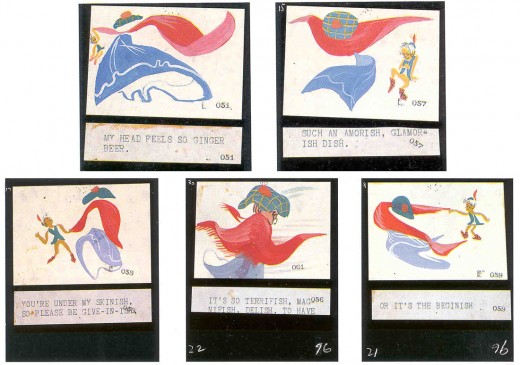
A sequence of color story continuity sketches by John Hubley for the
musical number “Something Sorta Grandish” sung by the love-struck
leprachaun Og as he dances with anthropomorphic laundry.
Animation was the medium chosen to bring Finian’s Rainbow to the screen simply because Hollywood’s live-action studios were reluctant to take on the property. (Eventually, in 1968, Fred Astaire starred in a leaden live-action film version directed by Francis Ford Coppola.) “The motion picture industry refused to make a movie of this smash musical because of its story content,” says Michael Shore, the entrepreneur who started the ball rolling toward an animated production in 1953. The show’s composer, Burton Lane, agrees: “The studios were a little fearful of the subject of racial discrimination.”
.
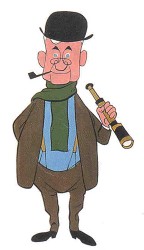 Finian’s Rainbow begins in Ireland, where wily old Finian McLonergan steals a pot of gold from the leprechaun Og. Finian travels with his daughter, Sharon, to America’s Rainbow Valley, a rundown tobacco plantation near Fort Knox, worked by black sharecroppers, where Finian believes the “peculiar nature of the soil lends an additional magi cal quality to gold.” He leases a parcel of land to bury the gold from Woody Mahoney and his sister, Susan the Silent, who dances to communicate (“foot-talkin”‘). Woody and Sharon fall in love. The tiny land parcel is also coveted by Judge Rawkins, a wealthy Southern bigot (“My family’s been having trouble with immigrants ever since we came to this country!”), who goes ballistic when a geologist discovers “an amazing concentration of gold” on the property. In the meantime, the leprechaun Og, who followed Finian to Rainbow Valley, is slowly becoming mortal as a punishment for losing the gold; he helplessly falls in love with both Sharon and Susan. Judge Rawkins attempts to dispossess Finian with a ___A color character model of
Finian’s Rainbow begins in Ireland, where wily old Finian McLonergan steals a pot of gold from the leprechaun Og. Finian travels with his daughter, Sharon, to America’s Rainbow Valley, a rundown tobacco plantation near Fort Knox, worked by black sharecroppers, where Finian believes the “peculiar nature of the soil lends an additional magi cal quality to gold.” He leases a parcel of land to bury the gold from Woody Mahoney and his sister, Susan the Silent, who dances to communicate (“foot-talkin”‘). Woody and Sharon fall in love. The tiny land parcel is also coveted by Judge Rawkins, a wealthy Southern bigot (“My family’s been having trouble with immigrants ever since we came to this country!”), who goes ballistic when a geologist discovers “an amazing concentration of gold” on the property. In the meantime, the leprechaun Og, who followed Finian to Rainbow Valley, is slowly becoming mortal as a punishment for losing the gold; he helplessly falls in love with both Sharon and Susan. Judge Rawkins attempts to dispossess Finian with a ___A color character model of
phony writ condemning the sharecroppers’ dwellings; but ____“himself,” Finian McLonergan,
when Sharon wishes (inadvertently over the magic gold) that_the film’s protagonist who was
Rawkins was in the sharecroppers’ shoes, his skin promptly __voiced by Barry Fitzgerald.
turns black.
The reviews for the Broadway production lavishly praised the performers, Michael Kidd’s choreography, the sets and lighting by Jo Mielziner, Burton Lane’s music, and E. Y. (Yip) Harburg’s lyrics (the show’s hit songs include “Old Devil Moon,” “How Are Things in Glocca Morra?,” “Look to the Rainbow,” and “If This Isn’t Love”), but they were less glowing about the book, which some critics faulted as an uneasy mix of fantasy and reality.
“Among other things,” wrote Richard Watts, Jr., in the New York Post, “Finian’s Rainbow is equipped with what may well be the most elaborate plot since War and Peace. Taking in its stride handsomely diversified elements from pseudo-Irish mythology, complete with an oversized leprechaun and a mystic pot of gold, to left-wing social criticism, embracing sharecroppers, the poll tax, anti-Negro senators, atomic energy, the gold at Fort Knox, the Tennessee Valley Authority, and the economic future of mankind, the book mingles the authors’ imagination with their politics amid much abandon…. If some of the political comment were just a little less blatant, the plot just a bit more inventive… the tale of the leprechaun’s mission to America would have been even happier.” Brooks Atkinson of the New York Times found the “stubborn shot-gun marriage of fairy-story and social significance… not altogether happy. The capriciousness of the invention does not last throughout the evening.”
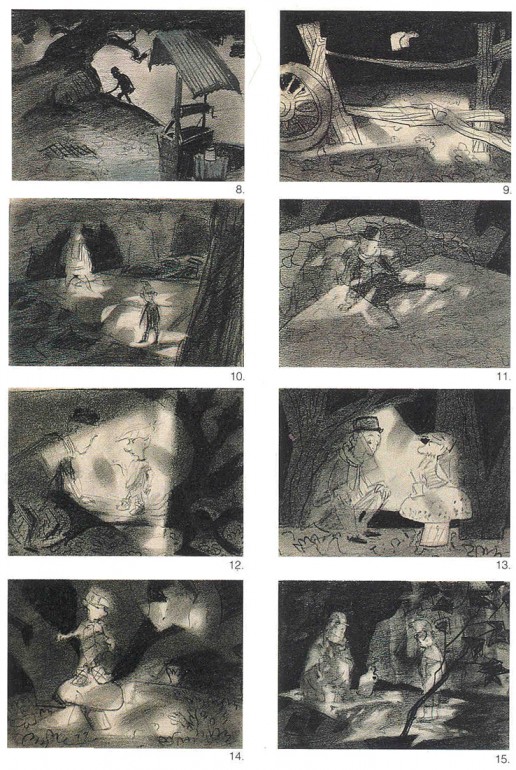
Exquisite charcoal story-continuity sketches, delicately rendered
by John Hubley, depict a sequence of moonlit magic wherein Finian
buries the stolen crock of gold – on which the plot of Finian’s Rainbow
hinges – and is confronted by Og. The voice of Og was supplied by David Wayne,
who originate the role in the Broadway production.
.
“It’s heavy-handed,” says Michael Shore, now 75. “I told Yip [co-author of the script with Fred Saidy] what bothered me about the property. It tells you that a terrible person turns black because he’s so bad, and then redeems himself and they reward him by making him white again.
“It occurred to me the story line could be made more palatable if it were done in animation. I had met Hubley. I was in the advertising business and had done some commercials with him. He was a towering genius! I made a deal with Yip to option Pinion’s for $10,000.1 underwrote the pre-production development of the property and paid Hubley to single-handedly do this remarkable storyboard. The story line became lighter and more acceptable.”
John Hubley (1914-1977) began his career in animation at age 22 at the Walt Disney Studio painting backgrounds for Snow White and the Seven Dwarfs (1937). [See PRINT, November/December 1981: "The Happy Accidents of the Hubleys."] He was an art director on Pinocchio (1940), Fantasia (1940), Dumbo (1941), and Bambi (1942) before participating in the acrimonious workers’ strike at Disney’s in 1941.
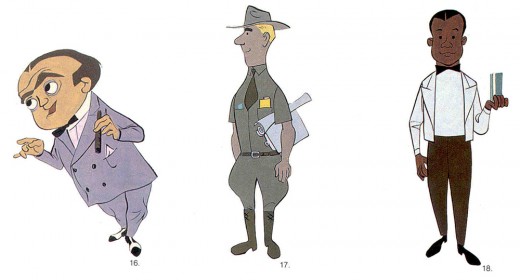
Color character sketches of Buzz, henchman and gofer for Judge Billboard Rawkins,
the story’s racial villain; a US geologist, and Howard, Judge Hawkin’s butler.
Finian’s Rainbow is an odd combination of fey fantasy and social commentary.
Walt Disney, who took the strike as a personal attack, found the opportunity to exact revenge on his renegade employees when he testified as a “friendly witness” before HUAC on October 24, 1947. He painted them bright Red. The strike, said Disney, was organized by “a Communist group trying to take over my artists and they did take them over.” Disney named names, including that of David Hilberman. Hilberman was a partner in the formation of a new animation studio, United Productions of America (UPA), staffed by dissident Disney artists, one of whom was John Hubley.
UPA’s design sensibility veered far from Disney naturalism into a modern art esthetic, and Hubley, from 1942 to 1952, was the studio’s most innovative supervising director. “In the early days,” he recalled many years later, “it was Picasso, Dufy, Matisse who influenced the drive to a direct childlike flat simplified design, rather than a Disney 18th-century watercolor. I also always had a terrific rebellion against the sweet sentimental chipmunks and bunnies idiom of animation, saying, ‘Why can’t these be human caricatures and get that same vitality in animation that still drawings have?’”
Earl Klein, an artist who worked with Hubley on storyboards and backgrounds for TV 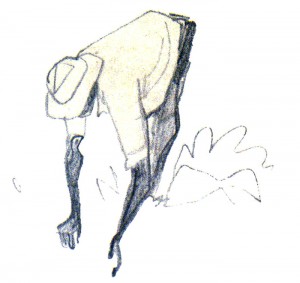 commercials in the ’50s, recalled in a 1990 interview with animation historian Michael Barrier that Hubley would ask his animators to volunteer to return to the studio in the evening. “[He] would play … a particular kind of music and have the animators go like a conga line around and around the room, listening to the music and trying to feel the rhythm and act out the emotions…. [He] said he wanted to break them away from the old established routine, the rubbery action movements that were so prevalent in those days… to influence them to be more creative in how they would see the human body in terms of animation.”
commercials in the ’50s, recalled in a 1990 interview with animation historian Michael Barrier that Hubley would ask his animators to volunteer to return to the studio in the evening. “[He] would play … a particular kind of music and have the animators go like a conga line around and around the room, listening to the music and trying to feel the rhythm and act out the emotions…. [He] said he wanted to break them away from the old established routine, the rubbery action movements that were so prevalent in those days… to influence them to be more creative in how they would see the human body in terms of animation.”

Colored pencil story sketches by Gregorio Prestopino
.
At UPA, Hubley co-created Mr. Magoo, supervised the studio’s first Academy Award-winning short, Gerald McBoing Boing (1951), and was nominated for an Oscar for his sassy stylized design and direction of Rooty Toot Toot (1952). “McBoing was a huge hit,” said Hubley. “The word started spreading that there was a new look to animation and Disney was finished!”*
Then the withering shadow of HUAC fell across UPA. “The Committee investigators dropped in and wanted the payroll book,” recalls animation director William Hurtz. “They went through names of anyone who worked there, checked some off and gave it to Columbia [UPA's film distributor], who came back and said these people have to be out of the studio or we yank the release. Most of the guys, including Hub, resigned rather than torpedo the studio. Least it could go on and some guys could have jobs. We were all on the Disney strike. I made the motion for the strike. It was a tight little club.”
“John didn’t leave voluntarily. He was kicked out!” comments Faith Hubley, John’s widow, who continues today to produce animated films at the Hubley Studio in New York City. Hubley freelanced for a nerve-racking year in Los Angeles, designing and directing animated TV commercials and, according to William Hurtz, “[making] himself scarce while the HUAC subpoenas were flying around.” Michael Shore was so concerned about Hubley’s mental state when he commissioned Hubley to create the Finian’s Rainbow storyboard in 1953, he ensconced the artist in a rented Sunset Plaza Drive house, “an isolated, beautiful setting with a 360-degree view of Los Angeles, where he could work uninterruptedly.”
“John was in love with Finian’s Rainbow,” says Faith Hubley. “It was to be the work of his life.”
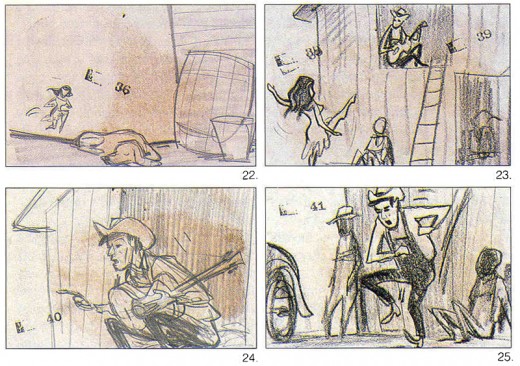
Story sketches (artist unknown) of Susan the silent rushing to tell her brother, Woody,
about trouble in Rainbow Valley, the rundown tobacco plantation located near
Fort Knox, KY. Woody’s voice was provided by Frank Sinatra.
The director’s script and surviving story sketches indicate how Hubley used the medium of animation—in which the impossible is made plausible—to wrest the narrative from the confines of live-action and release it into cartoon fantasy. Preceding the title and credits, for example, Finian McLonergan distracts the leprechaun Og from guarding a crock of gold by releasing a beautiful butterfly, onto which the tiny Og leaps, “soaring off into the misty woods.” As Og gradually becomes mortal throughout the film, eventually experiencing love for two human women, he expresses this new “glow-ish, kind of perculiarish sensation” by appearing and disappearing whole and in part throughout the film, and in one charming sequence, by performing a ballet-like dance with anthropomorphic wash from a clothesline.
Leprechauns aside, most of the cast is human, traditionally the most difficult type of character to animate convincingly. But Hubley caricatures the cast, even the romantic leads (Sharon and Woody), and the exaggeration works within the film’s overall art direction. The resultant visual freedom allows for stylish treatments of potentially deadening song duets: For “Old Devil Moon,” for instance, Hubley’s script notes an “abstract sequence and Boy and Girl symbols dancing with the moon.”
Hubley once stated that his impulse with Finian‘s was to “develop the visual art even further than the UPA films had.” He felt a “need to break through and to play around with more plasticity… to get a graphic look that was totally unique to animation, that had never been
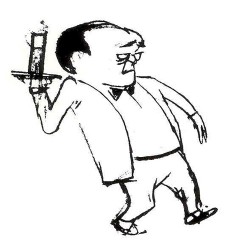 seen before.” Rooty Toot Toot, made a couple of years before Finian‘s, demonstrates Hubley’s superbly imaginative blending of caricatured humans with impressionistic settings. Tender Game (1958), a short he designed three years after Finian‘s, shows a further development of adventurous graphic experimentation using segmented, semi-abstract figures weaving into and out of translucent backgrounds. Michael Barrier once noted that Hubley’s graphic devices “… all serve, in the end, not to explicate ideas but to delineate character… .These films are as much concerned with personality as are the best Disney films… .They have sprung from the same seed, the urge to create new life.”
seen before.” Rooty Toot Toot, made a couple of years before Finian‘s, demonstrates Hubley’s superbly imaginative blending of caricatured humans with impressionistic settings. Tender Game (1958), a short he designed three years after Finian‘s, shows a further development of adventurous graphic experimentation using segmented, semi-abstract figures weaving into and out of translucent backgrounds. Michael Barrier once noted that Hubley’s graphic devices “… all serve, in the end, not to explicate ideas but to delineate character… .These films are as much concerned with personality as are the best Disney films… .They have sprung from the same seed, the urge to create new life.”
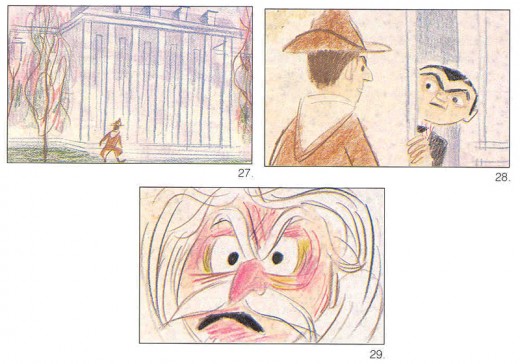
Story sketch samples from a sequence at the colonial estate
of Judge Rawkins. The judge’s voice is that of Jim Backus.
As Hubley continued to work happily on the Finian’s storyboard, Michael Shore was having “a lot of trouble raising funds. I brought on Maurice Binder, who later became well-known for making film titles, to seek other funding sources while I concentrated on Warner Brothers.”
Binder found the newly formed Distributors Corporation of America (DCA) in New York City, headed by Fred J. Schwartz. “We were intrigued by the project,” recalls Schwartz, now 81, whose father, Abraham H. Schwartz, founded the Century Theater movie circuit and initiated the anti-trust law suit that eventually broke up studio-owned theater circuits. “We made a deal and started to put everything together. We made the deal with Yip Harburg, Saidy, and Lane, who were wonderful people. You enjoyed and loved being with them. We started to make deals with all the artists.”
“When we had the DCA money,” recalls Shore, “we started to put the soundtrack together. I was friendly with Sinatra’s accountant and with Ella Fitzgerald’s manager. Sinatra was wildly excited. It was these two great names in music together for the first time. Then we attracted all the others.”
The dialogue and song tracks were recorded in five sessions in November and December 1954 on the Samuel Goldwyn lot in Hollywood, according to Ed O’Brien, coauthor with Scott P. Sayers, Jr., of Sinatra: The Man and His Music. The Recording Artistry of Francis Albert Sinatra 1939-1992 (TSI) Press, Austin, TX, 1992). “Sinatra was at the apex of his career,” says O’Brien. “He was filming Guys and Dolls [1955], he was in The Tender Trap [1955]. It was right at the beginning of the great Sinatra period at Capitol Records. In February of 1955, he recorded ‘The Wee Small Hours,’ which many consider the greatest ballad album ever recorded.” (Ironically, that is the same date Finian’s shut down.)
Listening to the surviving sections of the nearly 40-year-old track brings the project to exuberant life. Sinatra is indeed in top form, his voice confident and vital as it combines with Nelson Riddle’s distinctive brass and string arrangements and Lyn Murray’s conducting. Sinatra’s full-out, driving version of “That Great Come and Get It Day” is particularly exhilarating. The improvised “Ad Lib Blues” duet with Louis Armstrong offers one of the few times Sinatra sang “scat.” “I was there at the recording whenTouis Armstrong did The Begat,’ recalls Burton Lane. “The shape of the number was slightly altered to make it work for what Hubley had in mind for how the number would be shot.”
“On December 2, 1954,” says O’Brien, “Sinatra recorded ‘Old Devil Moon’ with Ella Logan [star of the Broadway Finian's], full orchestra, and the Jazz All-Stars: Red Norvo, Ray Brown, Herb Ellis, Oscar Peterson, and Frank Flynn. The vocal runs eight minutes, 20 seconds. There’s a jazz riff in the middle in which Peterson challenged Norvo. It’s extemporaneous and absolutely marvelous!” By contrast, a Sinatra duet with Ella Fitzgerald on “Necessity” swings lightly with only guitar, bass, and drums for accompaniment. The change from big-band arrangements into jazz throughout the film score got full approval from John Hubley, a longtime jazz enthusiast. “I used to go out with him some evenings to listen to live jazz,” recalls Earl Klein. “We went one night to hear Prez Prado. I was very impressed with his knowledge of music.”
Faith Hubley recalls: “Sinatra wrote out the words of Tenderly’ [a song not from Finian's] for Ella, who didn’t know all of them, for a lunch-time improv with Oscar Peterson, Ray Brown, and Herb Ellis.” The extemporaneous song was recorded and used in John and Faith Hubley’s 1958 short, Tender Game, making it the only trace of the Finian’s recording sessions currently available to the general public.
A studio was opened in Hollywood to house the animation crew Hubley began hiring to create additional story sketches, color background concepts, character design models, and animation layouts. “Hub tended to drop something on an artist,” says William Hurtz, “let him explore stuff, see what he came up with. Spent a lot of money that way. Very admirable. Hub spent so much on the track that there was hardly anything left to make the picture. That is a persistent story.”
Among the Finian’s Rainbow crew were production manager Les Goldman, the painter Gregorio Prestopino, and Disney/ UPA alumni Paul Julian, Aurelius Battaglia, Ray Sherwin, and Leo Salkin. “We had more art directors on that film than I can count,” Julian told Michael Barrier in 1986. “Everybody came on hired as an art director….
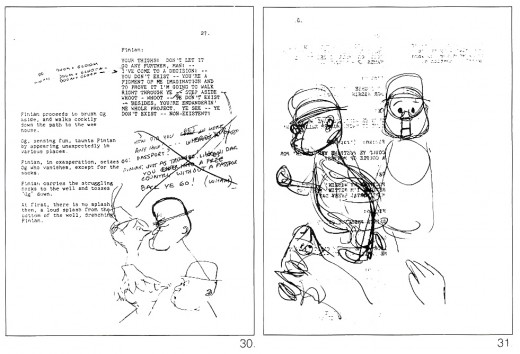
Two pages from director John Hubley’s script contain spontaneous doodles in the margins -
ideas for animation bits such as a nose wiggle for Og and a belligerent walk for Finian.
Finian’s basic shape recalls that of Mr. Magoo, a character co-created by Hubley.
Hubley had put a knife in his teeth and started climbing the rigging. In order to sell the package to the kind of really upstairs talent he wanted, he promised everybody 50 per cent of whatever there was. That is not much of an oversimplification.”
Slated to animate on the film were Bill Littlejohn and Art Babbitt, one of the Disney strike leaders. Work would also be farmed out to animator/Disney striker William Tytla in New York. Anita Alvarez, the original Susan the Silent in the Broadway Finian’s, danced in a reference film shot as an aid for the animators. Maurice Binder prepared a “Leica reel,” a film of the story sketches synchronized to the soundtrack.
According to Earl Klein, Hubley’s easygoing manner made him “hard to work with because he wasn’t very disciplined.” When they worked together on TV commercials, Klein discovered that tight production schedules did not unduly trouble Hubley. “Instead of getting the storyboard out, he would be interested in something else. But then he would come in and work all night long … [and] in the morning … he had a beautiful storyboard that he had just come up with, this wild idea.” Klein feels that “of all the people I worked with in a span of 30 years, John Hubley was probably the most talented . . . most creative person I ever knew… almost a genius. He was a superior designer, also a writer. He understood music and timing beautifully. I’ve seen him direct recording sessions with musicians.”
Faith Elliott, a film/music editor and script supervisor, arrived from New York in the fall of 1954 tb work as John Hubley’s assistant. John and Faith had been friends since the war years in Los Angeles; she saw the Finian’s boards the previous year at the Algonquin Hotel in Manhattan, where Hub-ley was briefly in hiding from the Hollywood HUAC. In 1955, they were married, leading Yip Harburg to comment ruefully that “the only people who got anything out of Finian‘s was you two!”
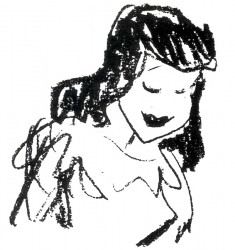 “There was a lot of tension in the studio,” Faith Hubley recently recalled. “Johnny had a tiny room with a piano and a sofa and an ocean of paper. He’d play the piano and get ideas and noodle around. Then there was that other room where all the people worked. The track was being recorded and edited, layouts were being made. The power situation was very, very complicated. Yip and Burton had a problem with all the jazz. Yip would complain, ‘You can’t hear the lyrics.’” Michael Shore recalls: “We had some trouble with Yip. He kept questioning Hubley’s drawings of a leprechaun. He stuck his nose in everything.” “In a sort of combination of jeers and fears,” Paul Julian recalled to Michael Barrier, “the people who were putting up the heavy loot were totally ignorant of animation, as a working process, and they kept asking to see yesterday’s dailies’ [footage developed overnight].”
“There was a lot of tension in the studio,” Faith Hubley recently recalled. “Johnny had a tiny room with a piano and a sofa and an ocean of paper. He’d play the piano and get ideas and noodle around. Then there was that other room where all the people worked. The track was being recorded and edited, layouts were being made. The power situation was very, very complicated. Yip and Burton had a problem with all the jazz. Yip would complain, ‘You can’t hear the lyrics.’” Michael Shore recalls: “We had some trouble with Yip. He kept questioning Hubley’s drawings of a leprechaun. He stuck his nose in everything.” “In a sort of combination of jeers and fears,” Paul Julian recalled to Michael Barrier, “the people who were putting up the heavy loot were totally ignorant of animation, as a working process, and they kept asking to see yesterday’s dailies’ [footage developed overnight].”
“Johnny was the director with creative control,” says Faith Hubley, “and Johnny was very strong. There was a certain amount of tension about where the picture was going—would it be too advanced for the great American public?”
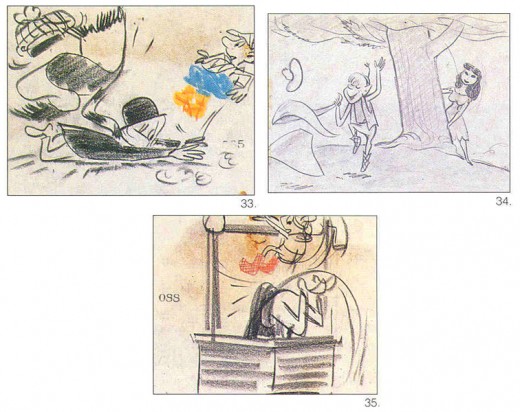
Og pursues Susan the Silent and escapes Finian, who falls down a well,
in a series of rough story sketches by John Hubley.
During this intense, anxious period, Michael Shore, the man who had conceived of the production as animation, had paid for the pre-production storyboard, and had put together elements for the spectacular soundtrack, found himself “on the outside looking in. I couldn’t even get into the office.” Angry, he went to Binder, who said, “Don’t rock the boat.” “I couldn’t bother Yip,” says Shore. “He turned his back on me.” Finally, he confronted Hubley, meeting with him “across from Schwab’s drugstore. I said, ‘I don’t want to bother anybody, but I’m being treated shabbily.’ To my surprise, John was very doctrinaire. He may have had more leftish leanings than I thought. He said, ‘I don’t give a damn. I can only think of the picture. To hell with emotions. I’ve got a job to do!’ I said he was being less than reasonable. This was my project. From day one, I had brought it to a certain point and I was going to re-introduce myself to the project. My lawyer met with DCA and we managed to shut down the production for two days while they negotiated an agreement that acceded to my involvement—a promise to return monies, an assurance of screen credit, and so on. Of course, it turned out to be a Pyrrhic victory.” Earl Klein recalls: “Hubley got so involved with the problems of Finian’s Rainbow that he began to turn a little sour and become unpredictable.”
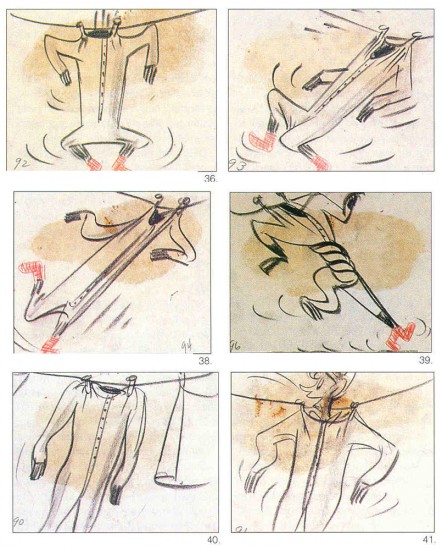
“Another pressure,” says Faith Hubley, “was the complicated representative situation. SCG [Screen Cartoonists Guild] was not IA [IATSE: International Alliance of Theatrical Stage Employees]. It had to be IA, otherwise Finian’s couldn’t play in theaters.” Bill Little-John, who was the first president of SCG, recalls he was told “I’d have to become a member of the IATSE, which had taken over Disney, UPA, MGM, Lantz, Warner’s. SCG still had contracts with the smaller studios that did TV commercials and special projects. I said the studio doesn’t select the representative of choice. It’s up to the employees. Well, that hit the fan. The backers of the film were deeply entrenched with the IATSE element; that got their backs up and created complications.”
Just how involved the IATSE was became clear when Fred J. Schwartz got a phone call from Roy Brewer, leader of the IATSE, chairman of the AFL Film Council, and chairman of the executive committee of the Motion Picture Alliance for the Preservation of American Ideals. In A Journal of the Plague Years (Atheneum, New York, 1973), author Stefan Kanfer describes Brewer as one of Hollywood’s toughest “stainless-steel” anti-Communists, a man who “no longer played the ruthless prosecutor,” preferring “the part of father-confessor, guide to the tortured and lorn.” William Hurtz recalls a command visit to Brewer’s office during the UPA purge to “listen to him lecture us on the error of our ways for being duped 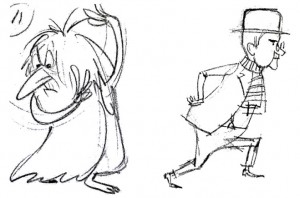 by Reds, by associating with Hub and a number of the other guys.”
by Reds, by associating with Hub and a number of the other guys.”
Brewer told Schwartz he thought he was “in trouble. You’ve got a problem. Let’s meet.” The problem turned out to be John Hubley, who Brewer said “is suspect and refuses to appear before the Hollywood Committee. If he doesn’t appear and clear himself, you lose your money, you lose everything.” A shaken Schwartz met with Hubley.
“This was a very distasteful conversation for me, but I had no choice but to go through with it,” Schwartz recalls. “I said, ‘John, I got this call and I have to ask you a question. I have to swallow hard before I ask it. I want you to know I don’t believe in it, but I’m faced with a terrible situation with many individuals at risk.’ I asked, ‘Were you ever a member of the Communist party?’
“He said, ‘No. Definitely not! I will admit that like many other artists in Hollywood, I belonged to some organizations that had high-sounding names and when I found out they were fronts for the Communist party, I left them. That’s as far as I ever went.’
“I said, ‘John, we have $365,000 in the project.’ Forty years ago, that was substantial. I said, There are other people involved. Go before the Committee and clear yourself, so we can go ahead.’ He said, ‘I would be happy to, but Freddy, they’re going to ask me to name other names, and that I won’t do!”
Upon learning of Hubley’s refusal to testify, DCA’s parent company, Century Film, and their lender, Chemical Bank, decided to drop financial support of the film. But Schwartz did not give up. He sought and found $75,000 in backing from RKO, about a third of the amount needed to finish the film. Check in hand, Schwartz again approached Century. The company still refused. “And Chemical Bank said, If your own company turned you down, we can’t lend you the money,” says Schwartz, who with great sadness instructed DCA’s West Coast representative, Milton Pickman, to close the studio.
To the filmmakers, unaware of Schwartz’s desperate month-long search for money, the closing of the studio came with shocking suddenness. “It was electric!’ recalls Faith Hubley. “They impounded everything,” says designer Paul Julian, “including my stopwatch.”
“The banks refused to put up the money and it all fell apart,” says Burton Lane. “The McCarthy era was one of the worst periods. Half of my friends acted with honor and half acted with dishonor, so I gave them up. John Hubley acted with honor.” The blacklist tarred Burton’s colleague Yip Harburg, leading to, among other things, the revoking of his passport and a 12-year gap in his employment as a lyricist for movies. Earl Klein believes that word of a Harburg/Hubley collaboration originally alerted IATSE, and Hubley’s non-cooperation with HUAC doomed the production: “. . . word got around that you weren’t supposed to touch it. It was actually a blacklist and a boycott situation…. [Hubley] was in a position where the lab technicians wouldn’t handle any of… the pencil tests or anything like that. This made it impossible for them to proceed and the project had to be dropped.”
The letdown was enormous for all the parties involved. “My heart ached when it didn’t happen,” says Michael Shore. Paul Julian calls it “tragic.” “A big disappointment,” says Burton Lane. Years later, even Sinatra’s music arranger, Nelson Riddle, commented to Ed O’Brien, “It is a tragedy what happened to Finian’s.”
“What happened to me? Trouble,” says Fred Schwartz. “I was in a terrible position. The company [DCA] went under, but I had to stay with it. I didn’t have to, but I felt it was right because we owed the bank a lot of money. While I wasn’t personally liable, the company was. The bank loaned the money in part because they believed in the venture and had confidence in me. I couldn’t walk away. So I stayed with it for six years till I paid off the bank. My partners both left their jobs. They were angry at the circumstances. One had two small children at the time. You know what that made me feel like?”
“The blacklist was that powerful,” Schwartz continues. “This is an example of what happens when you squelch talent. Which is directly against everything we stand for, such as freedom of speech. This could have been a classic that would live forever.”
“The blacklist should never happen again. It certainly affected the history of animation,” asserts Faith Hubley. “If Finian’s had been finished, we’d have seen wonderful animated films of substance and content.”
HUAC eventually caught up with John Hubley; he testified for two hours and ten minutes on July 5,1956, but refused to name names, invoking his Constitutional privilege under the First and Fifth Amendments. By that time, however, HUAC and the blacklist’s power were fading; the Hubleys moved to New York, and over the years produced a series of personal animated shorts, which eventually garnered three Oscars, among other awards. “It was sad for me that Finian’s was never finished,” says Faith Hubley, “but it enabled a number of us to grow up and become strong, mature people who made all those good movies. If John had had a career doing Hollywood features, he would never have become an independent.”
Rights to the animated Finian’s and the shards of the aborted production went to a New York company, Transfilm Productions. Ironically, David Hilberman, whose name Walt Disney had put before HUAC in 1947, was hired by Transfilm, as he recently explained in a letter, to “look into how much of the picture was completed and how much time it would take to finish it.” Hilberman had been directing films in “self-imposed exile in England” after his New York studio, Tempo, was blacklisted and closed in late 1953. Consequently, he says he “was not aware of what happened in the industry…. I don’t recall any discussion about who [would work on the project] and where the project would be completed. I see now I should have checked with John Hubley, but I guess I thought that might be awkward— I am very disturbed that the Hubley production was stopped by HUAC/Brewer/black-list. Had I known, I wouldn’t have touched the assignment with a 10-foot pole!” In any case, Transfilm did not pursue the project further.
Some years after the Finian’s Rainbow debacle, entrepreneur Michael Shore approached Fred Schwartz about an animated production of Don Quixote to be storyboarded by none other than Picasso. But that’s another story.
Acknowledgment: Besides the individuals mentioned in his article, the author would like to thank the following for their help and cooperation: Michael Sporn, David Hilberman, Ernie Har-burg.Jean Gordon, Jim Logan, Nick Markovich, Brian Mainolfi, Camille Dee, Mayann Chach, Adrienne Tytla, and Amanda Deitsch (Sotheby’s, New York).
